| Energy
Conservation Sites |
|
| Home Energy Saver
Audit/Calculator
http://hes.lbl.gov/
|
 A Do-It-Yourself home energy
audit A Do-It-Yourself home energy
audit
Fill in details on your home location, size, construction, etc.
The calculator estimates your current energy use, makes
recommendations on changes and estimates the cost saving and
pollution benefits.
|
| An Interactive Tool for
Saving Energy at Home
Interactive Home Energy Saving Tool
|
 A cute new tool from Energy Star that identifies
energy saving tips on a room by room basis. A cute new tool from Energy Star that identifies
energy saving tips on a room by room basis.
You can give to your kids, and let them nag you into making some
energy saving changes to make the planet better for them. |
| Energy Savers from DOE EERE
site
http://www.eere.energy.gov/consumer/tips/
Energy Tips
from EERE (2.7MB pdf)
|
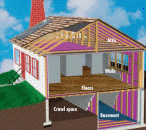 "Energy Savers" for home owners
(insulation, appliances, lighting, ...) energy saving advice. "Energy Savers" for home owners
(insulation, appliances, lighting, ...) energy saving advice.
The Energy Tips 36 page booklet is good.
|
| Home Energy Briefs -- Rocky
Mountain Institute
Home Energy Briefs:
http://www.rmi.org/pid217
|
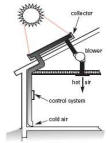 These are good, practical guides on
energy saving that (I believe) exhibit a high level of technical
accuracy (a rarity), and can provide good guidance on which energy
saving changes are most cost effective. The guides are very
straightforward and readable. There are other places that offer
more detailed information on every subject, but this is a really
good place to start. These are good, practical guides on
energy saving that (I believe) exhibit a high level of technical
accuracy (a rarity), and can provide good guidance on which energy
saving changes are most cost effective. The guides are very
straightforward and readable. There are other places that offer
more detailed information on every subject, but this is a really
good place to start.
Titles:
Building Envelope
Lighting
Space Cooling
Space Heating
Water Heating
Cleaning Appliances (washers, dryers, ...)
Electronics
Kitchen Appliances
Whole System Design |
| Energy Star Home Energy
Yardstick
http://www.energystar.gov
|
 A helpful and easy to use Energy Star
calculator you can use to see how your homes energy efficiency
compares to others in your area. A helpful and easy to use Energy Star
calculator you can use to see how your homes energy efficiency
compares to others in your area. |
| Energy Star
Energy
Star Ratings ...
|
Energy ratings and energy use for
appliances. Energy advice and online audit for homes. Energy
star appliances and homes.
In my view, the Energy Star program could be more aggressive, but
its certainly a good place to start. For example, they have no
plans to require more efficient refrigerators until 2012 at the
earliest -- let them know you would like to see a more aggressive
approach. |
Energy Star Rebates Finder
and Federal Tax Credits Information
Find rebates in your area:
http://www.energystar.gov
Federal Tax Credits for Energy Efficiency:
http://www.energystar.gov
|
 Two helpful
items from the Energy Star website: Two helpful
items from the Energy Star website:
The first finds rebates on a large variety of energy saving
projects. Enter your zip code, and Energy Star returns a list of
available rebates in your area. This is hard to find on the
EStar site, so keep the link.
The 2nd is a detailed list of the federal government tax credits. |
|
Natural Gas Appliance Calculator,
Wisconsin Public Service
http://www.wisconsinpublicservice.com/home/gas_calculator.aspx
|
 Very handy
calculator for estimating gas use as cost for the common gas
appliances. Very handy
calculator for estimating gas use as cost for the common gas
appliances. |
Saving Electricity,
Michael Bluejay
http://michaelbluejay.com/electricity/
|
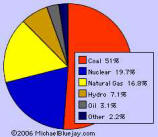 This is a good
site on saving electricity. It provides in depth information on
what uses electricity, how much it uses, ideas for saving, and good
ways to estimate how much you will save for each idea. This is a good
site on saving electricity. It provides in depth information on
what uses electricity, how much it uses, ideas for saving, and good
ways to estimate how much you will save for each idea. |
| HEED
http://www.energy-design-tools.aud.ucla.edu/heed/
|
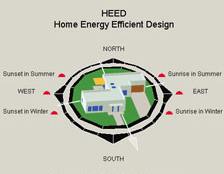 This is very
easy to use, yet very capable simulation software for estimating the
energy/thermal performance of a passive solar or conventional home.
Weather files for over 500 worldwide locations. It can be used to
evaluate the benefits of adding insulation or other energy
conserving features. Its a free download. This is very
easy to use, yet very capable simulation software for estimating the
energy/thermal performance of a passive solar or conventional home.
Weather files for over 500 worldwide locations. It can be used to
evaluate the benefits of adding insulation or other energy
conserving features. Its a free download. |
| EFI -- Energy Federation
Incorporated
http://www.efi.org/about.html
|
 EFI supplies a wide variety
of energy conservation products at what appear to be reasonable
prices -- including this "Comfy Critter Draft Dodger". EFI supplies a wide variety
of energy conservation products at what appear to be reasonable
prices -- including this "Comfy Critter Draft Dodger".
Lights, sealers, thermostats, ...
Some nice kid products on the Educational page.
|
| Eco
Renovator
The forum is here:
http://ecorenovator.org/forum/
The blog/website is here:
http://ecorenovator.org/
|
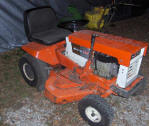 A personal site with many
interesting articles on a wide range of conservation, efficiency,
green house gas, and solar projects. And, a discussion forum. A personal site with many
interesting articles on a wide range of conservation, efficiency,
green house gas, and solar projects. And, a discussion forum.
Quite a few DIY projects. |
| Insulating
and Weatherizing Guides and Projects |
| Insulation
Upgrade Cost Saving Calculator
|
 Calculate
how much money and greenhouse gas you would save with various
insulation, window, or window treatment upgrades. Calculate
how much money and greenhouse gas you would save with various
insulation, window, or window treatment upgrades. |
A
Do-It-Yourself Guide To Energy Star Home Sealing
Energy
Star Home Sealing Guide... (2 MB pdf)
Leaky ducts may lose lose
15% to 30% of your heated or cooled air ---- more
on duct sealing
NEW!
Don't use duct tape for sealing -- example ...
|
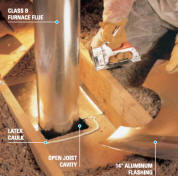 This is a very well done guide to sealing up air
leaks in your home. Lots of good how-to pictures. This is a very well done guide to sealing up air
leaks in your home. Lots of good how-to pictures.
A couple small add-ons I would make:
- Replacing older can lights so that you can insulate right over
them is a fairly easy DIY job -- it has the advantages of both
reducing heat loss to the attic and getting some heat gain from the
can light to the room.
- The method they give for determining if you have enough insulation
is goofy. Instead, use the
Insulation Upgrade Calculator or one of the online insulation
guides to determine if your insulation is sufficient for your
climate.
- For insulating over existing insulation, I like blown in
cellulose. Its easy, insulates very well, is resistant to air
currents flowing through it (see study below), and is easy on the
planet. |
| Insulate and Weatherize
Bruce Harley
|
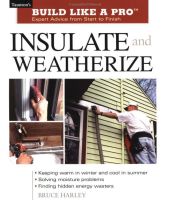 Very, very good book on techniques for
improving home insulation, reducing air infiltration, and sealing
ductwork. The most complete and technically correct reference I
have found. Very, very good book on techniques for
improving home insulation, reducing air infiltration, and sealing
ductwork. The most complete and technically correct reference I
have found. |
Home Remedies for Energy
Nosebleeds,
Bruce Harley, Fine Homebuilding, Issue 190
How to
get articles from Fine Homebuilding ...
|
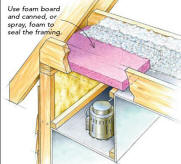 Fine Homebuilding Magazine,
Nov 2007, Issue 190. A good article by Bruce Harley (author of the
book just above) about finding and fixing particularly bad energy
wasting defects in your house. Fine Homebuilding Magazine,
Nov 2007, Issue 190. A good article by Bruce Harley (author of the
book just above) about finding and fixing particularly bad energy
wasting defects in your house.
These are the kinds of things that can raise your heat bill by 50%
or more. |
Insulation Guides --
Building a well insulated and Tight Shell for Your Home
The DOE-EERE Insulation Guide Series:
Insulation
Overview (pdf 2MB)
Insulating Ceilings/Attics (pdf 0.1MB)
Wall
Framing (pdf 0.8MB)
Insulating
Walls (pdf 0.8MB)
Insulating
Basements (pdf 0.2MB)
Insulating
Crawl Spaces (pdf 0.2MB)
Insulating
Slabs (pdf 0.2MB)
Window
Selection (pdf 0.5 MB)
Air
Sealing (pdf 0.2MB)
Weather
Barriers (pdf 0.2MB)
|
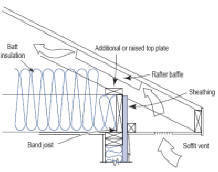 This is a good and
up-to-date series of guides from DOE-EERE site for building an outer
shell on your home that minimizes heat transfer. This is a good and
up-to-date series of guides from DOE-EERE site for building an outer
shell on your home that minimizes heat transfer.
I guess my one bit of advice would be to go a bit further than they
recommend for your climate, because experience shows that in a while
(as fuel prices climb) they will be recommending higher levels.
Other DOE-EERE publications here:
www.eere.energy.gov/buildings/info/publications.html
|
Global
Warming #GWPImpact of Various Insulating
Materials
www.buildinggreen.com/...
Alex Wilson, Building Green |
 Some insulating
materials have large global warming impacts because of the blowing
agent used to make them. Some insulating
materials have large global warming impacts because of the blowing
agent used to make them.
Extruded Polystyrene (XPS) and closed cell foam in place
polyurethane (SPF) are particularly bad.
Cellulose, polyisocyanurate board, expanded polystyrene and several
others have very low global warming impacts.
This article looks a the global warming payback for insulation used
OVER an insulated 2 by 6 wall -- the payback runs into several
decades for the XPS.
Polyisocyanurate (Polyiso) board insulation is readily available,
has a very high R value per inch, and low global warming impact --
seems like a good bet when rigid foam insulation is needed. |
|
|
|
| Insulation
Fact Sheet (pdf)
Fairbanks University Cooperative Extension Service
|
A very good
table providing information on all the common (and not so common)
types of insulation.
R values, application suitability, pro/con, max service
temperature, ...
Very Useful, and, as far as I can see, unbiased (which is hard to
find in insulation info on the Internet).
|
Insulating
Your Old House, (A wall insulation how-to)
Laren Corie,
ESSN Newsletter, Aug 2005
http://www.rebelwolf.com/essn/ESSN-Aug2005.pdf
|
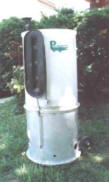 This is a good
article by Laren Corie in the Aug 2005 issue of the ESSN Newsletter. This is a good
article by Laren Corie in the Aug 2005 issue of the ESSN Newsletter.
It describes in detail how to insulate existing walls with cellulose
insulation.
The ESSN news letter, while not published anymore has some very good
articles in its online archive -- all free downloads.
http://www.rebelwolf.com/essn.html |
| Insulating
Existing Walls with Blown In Insulation
Gary
|
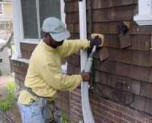 Some collected
information on how-to blow insulation into your existing walls. Some collected
information on how-to blow insulation into your existing walls. |
Insulating
with Spray Cellulose,
Michael Uniacke, Journal of Light Construction
Journal of Light
Construction ...
www.advancedinsulationinc.com/... |
 Good
article from the JLC giving the details on wet spray cellulose for
walls. This technique has become quite popular with professional
installers and offers many advantages over fiberglass batts. Good
article from the JLC giving the details on wet spray cellulose for
walls. This technique has become quite popular with professional
installers and offers many advantages over fiberglass batts.
This normally has to be a professional installation because of the
specialized equipment, but it can be a good way to go. |
|
Guide To Installing Fiberglass Batt Insulation
http://insulationinstitute.org/wp-content/uploads/2016/03/NAIMA-Tech-Tips-and-Critical-Details-FINAL.pdf
|
 A
good guide on installing fiberglass batt insulation with lots of
information on how to handle all the issues of fitting the batts
around objects and into odd places. A
good guide on installing fiberglass batt insulation with lots of
information on how to handle all the issues of fitting the batts
around objects and into odd places.
One of the problems with fiberglass insulation is that if its not
fitted carefully its effectiveness is significantly reduced. This
guide will help you do a good job.
Its also very important to seal all air infiltration paths before
installing the insulation. |
|
How to Insulate a Basement (or Crawlspace) Wall,
Martin Holladay, GreenBuildingAdvisor.com blog
Another GBA article from Marc Rosenbaum on basement
wall insulation -- lots of good detail...
|
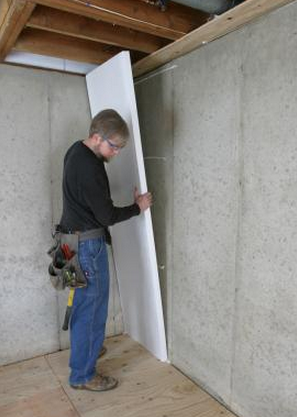 A good blog on the Green
Building Advisor blog on the do's and don'ts of insulating a
concrete basement wall. A good blog on the Green
Building Advisor blog on the do's and don'ts of insulating a
concrete basement wall.
Includes choosing between inside and outside insulation, how to
avoid moisture problems and quite a bit more.
|
Building
and Using a Blower Door -- A DIY Blower Door you can Build for $30
All the details on our homemade
blower door... |
 This
is our homemade blower door that uses a furnace blower for the fan. This
is our homemade blower door that uses a furnace blower for the fan.
The writeup gives all the details on building and using the blower
door, and the methods you can use to compare
your house tightness to others as well as estimate the heat loss and
carbon emissions associated with infiltration. and the methods you can use to compare
your house tightness to others as well as estimate the heat loss and
carbon emissions associated with infiltration.
With a little scrounging, the blower door and instrumentation can be
built for $30. |
|
DIY Blower Door
Plans -- North Dakota Sate University Extension
Plans
for blower door....
URL
for NDSU Extension service -- many free plans...
|
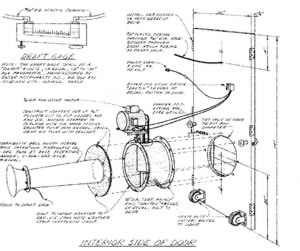 This is a set of plans
from the North Dakota State University extension for a DIY blower
door. This is a set of plans
from the North Dakota State University extension for a DIY blower
door.
I ran into these plans after building the blower door just above
-- not sure which is easier or cheaper or better.
|
|
Duct Losses Hurt Forced Air Heating System
Performance
Energy
Star Guide on Duct Sealing...
|
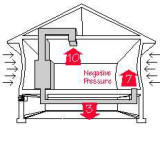 Energy Star
resource page on duct sealing. Fforced air duct systems often show a
30% loss in heating and cooling efficiency due to duct leaks and
poor duct insulation is typical. Energy Star
resource page on duct sealing. Fforced air duct systems often show a
30% loss in heating and cooling efficiency due to duct leaks and
poor duct insulation is typical.
Five bucks for a can of duct mastic and a half a days work could
save you a lot on heating fuel and green house gas emissions.
See the sealing guides in this section or the Harley book for how to
do the sealing. |
|
Buried and Ecapsulated
HVAC Ducts,
DOE Building America
Summary of buried and ecapsulated duct study...
|
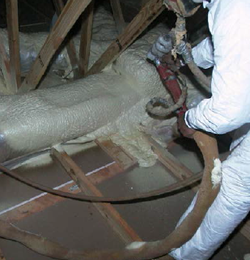 Heating or cooling ducts
running through the attic can be large energy consumers compared
to ducts run within the conditioned space. Heating or cooling ducts
running through the attic can be large energy consumers compared
to ducts run within the conditioned space.
This study looks at a scheme for encapsulating the ducting in
spray foam insulation and then covering the ducting with loose
fill insulation. This brings the performance of ducts running
through the attic to about the same level as ducts running through
the conditioned space.
|
| More on Duct Sealing
AeroSEAL Duct Sealing System
http://www.aeroseal.com/index.php
|
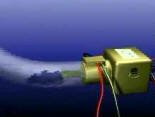 This is a process for
sealing ducts that works for the inside. It will reach areas of the
duct system that are built into walls or otherwise inaccessible. This is a process for
sealing ducts that works for the inside. It will reach areas of the
duct system that are built into walls or otherwise inaccessible.
Here is a comment from the Greenbuilding
Discussion Group (
http://www.buildinggreen.com/elists/gb_signup.cfm ):
"I have sealed many duct systems by removing the
grills/registers and using UL-181 duct mastic on all the
joints I can reach. I then seal everything accessible at the
furnace that is accessible. Most of the time I get to below 6%
(California code for new ducts) without touching anything
else. If I don't get below 6% then I go to the duct runs that
are accessible. Only very large duct systems, and those with
ducts buried I can't get below 6%, but I'm usually close.
I know the person who developed Aroseal, you have to do some
manual work anyway with larger holes (grills/registers ?) and
you will only get as tight as the operator has time to sit
around pumping more sealant into the ducts. It is a great
process for inaccessible duct systems that can't be sealed
otherwise."
|
Advanced Air Sealing,
Oikos
http://www.oikos.com/library/airsealing/index.html
|
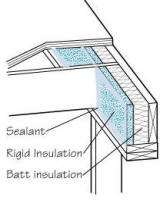 This is quite a
detailed and helpful guide on how to seal various joints and
penetrations. This is quite a
detailed and helpful guide on how to seal various joints and
penetrations.
Some of these techniques can only be used during construction,
but some can be used on an existing house.
|
| Home Energy Projects
Home
Energy Projects - An Energy Conservation Guide for
Do-It-Yourselfers...
From SouthFace.org --
lots of good informaiton here.
|
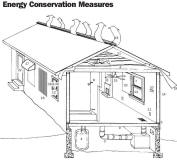 Home Energy
Projects -- Good, detailed guide on DIY energy conservation
projects. Written for Alabama, but many projects are good for
anywhere. Home Energy
Projects -- Good, detailed guide on DIY energy conservation
projects. Written for Alabama, but many projects are good for
anywhere.
" An Energy Conservation Guide for Do-It-Yourselfers - 1.3mb pdf
file. This book was created for the state of Alabama with
information that applies throughout the southeast U.S. Home Energy
Projects contains 86-pages and outlines 25 energy conservation
projects, in order of priority, that can be performed by
do-it-yourselfers. Contains how-to instructions"
|
|
All About Insulation
DanChiras
Mother Earth News
Finding
Mother Earth News articles...
|
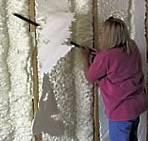 Mother Earth
News Article, Issue 194 Mother Earth
News Article, Issue 194
Good rundown on the various types of insulation available and
their insulating, health, and environmental characteristics.
|
Spray
Foam -- What Do You Really Know?,
Bob Yagid, Fine Homebuilding, June 2009
How to
get articles from Fine Homebuilding ...
|
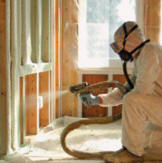 A Fine Homebuilding article
explaining the two type of spray foam insulation. A Fine Homebuilding article
explaining the two type of spray foam insulation. |
|
Save Energy and Money Now
Mother Earth News
Finding
Mother Earth News articles...
|
Mother Earth News Article,
Issue 188
Article outlines a number of practical steps to reduce your homes
energy consumption.
|
|
Are You Insulated
Edward Harland
Mother Earth News
Finding
Mother Earth News articles...
|
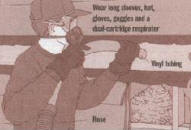 Mother Earth News Article,
Issue 153 Mother Earth News Article,
Issue 153
Pretty good article on insulating existing
houses. Good for a starter, but get the Harley book before you
tackle the actual project.
|
| Air Sealing
From Southface at: www.Southface.org
Air Sealing
Guide (139K pdf)
|
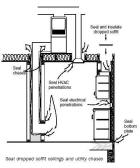 Good, detailed
guide on sealing houses to reduce air infiltration. Good, detailed
guide on sealing houses to reduce air infiltration.
From the Southface website -- other good material on this site.
|
| Operation Caulk -- Air
Sealing Procedure for DC Habitat For Humanity Duplex Houses
Operation Caulk (200K
pdf)
|
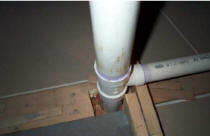 A good and detailed guide on
sealing to reduce air infiltration. A good and detailed guide on
sealing to reduce air infiltration.
While the guide is intended for new construction, some of the
steps can be taken on an existing house.
From:
http://www.greenhome.org/index.htm
|
Attic
Insulation Upgrade,
Mike Guertin, Fine Homebuilding, January 2009
How to
get articles from Fine Homebuilding ...
|
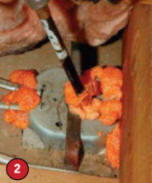 A good article from Fine
Homebuilding on adding insulation to the attic. Lots of emphasis
and detail on sealing before insulation, which is very important --
careful sealing of air leaks may save more energy than the
insulation. A good article from Fine
Homebuilding on adding insulation to the attic. Lots of emphasis
and detail on sealing before insulation, which is very important --
careful sealing of air leaks may save more energy than the
insulation.
|
| An Effective Pet
Door Air Infiltration Solution
Installing a pet door with an
effective infiltration seal...
|
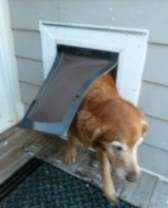 The blower door test we had
recently showed a lot of infiltration through our pet door. The blower door test we had
recently showed a lot of infiltration through our pet door.
In looking for a way to cut this down, we found this Freedom Pet
Pass door, which has a much more effective air infiltration seal
that has cut the pet door infiltration to near zero.
It also stops the pet door from flapping during windy periods.
All the details...
|
Airtight
Attic Access,
Mike Guertin, Fine Homebuilding, July 2002 issue 148
How to
get articles from Fine Homebuilding ...
|
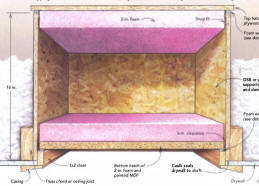 Fine Homebuilding article
shows a design for a double door access into the attic. Fine Homebuilding article
shows a design for a double door access into the attic.
Attic access hatches can be a HUGE large heat loss -- they ae
often poorly insulated and very leaky. This is a simple way to
make sure yours is not.
|
Attic Venting, Attic
Moisture and Ice Dams,
Canada Mortgage and Housing Corporation
http://www.cmhc-schl.gc.ca/en/co/grho/moaiprre/moaiprre_009.cfm
|
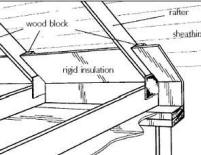 Good fact sheet on what to
do about wet attics and ice dams. Good fact sheet on what to
do about wet attics and ice dams. |
How
to Install Radiant Barrier Foil Insulation
Three sites that offer radiant barrier installation instructions.
AtticFoil.com
InsulationStop.com
www.EcoFoil.com
|
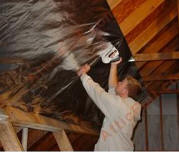 This is a
detailed and well written set of instructions on how to install a
radiant barrier. This is a
detailed and well written set of instructions on how to install a
radiant barrier.
This same outfit sells a "heavyweight" aluminum foil material for
about 12 cents a sf. |
| Blower Door Testing
From the Southface.org website
Blower Door
Test Guide (50K pdf)
|
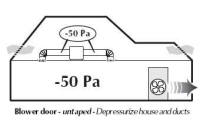 Good guide on
how blower door testing and duct blast testing can be used to test
for the level of air infiltration your house if experiencing. Good guide on
how blower door testing and duct blast testing can be used to test
for the level of air infiltration your house if experiencing. |
|
DOE/ORNL
Insulation Fact Sheet...
|
Advice on where to insulate,
what to insulate with, and installation advice.
Recommendations on insulation levels that are dependant on
climate and construction type.
|
| Crawl Space Insulation
http://www.advancedenergy.org/portal/crawl_spaces/
Crawl Space Quick Reference...
|
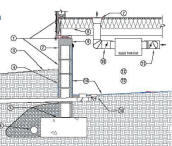 Closed
(unvented) crawl spaces can reduce heat loss, but have to be done
correctly. This site has lots of detailed information on how to
decide on whether to close your crawl space, and how to do it. Closed
(unvented) crawl spaces can reduce heat loss, but have to be done
correctly. This site has lots of detailed information on how to
decide on whether to close your crawl space, and how to do it. |
| Retrofitting Insulation to
Existing Homes
Retrofit
Insulation in Existing Wooden Walls (pdf)
Retrofit
Insulation in Wood Roofs (pdf)
Retrofit
Insulation in Concrete and Masonry Walls (pdf)
Alaska Building Research Series HCM-01552,3, and 4
|
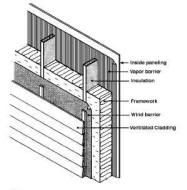
This series of three papers shows some techniques for
retrofitting insulation to existing walls, roofs, and
concrete/masonry walls.
Good construction details.
These are not the only ways to retrofit insulation to walls, and
may not be appropriate for all climates -- but, may be perfect for
some situations.
|
| Mooney Wall
|
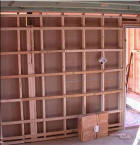 A way to
retrofit a high R value, low thermal bridging, and high infiltration
resistance wall. A way to
retrofit a high R value, low thermal bridging, and high infiltration
resistance wall.
Mooney wall details ...
Another example of using the
Mooney wall ...
|
| Comparison of Fiberglass and
Cellulose Insulation in Identical Test Homes
FG to
Cellulose Compare (0.2MB pdf)
|
Heat Loss test for two small
test homes, one insulated with fiberglass and the other with
Cellulose insulation.
Cellulose showed more resistance to infiltration and better R
value than fiberglass.
|
|
Convection Losses in Loose Fill Fiberglass Insulation
ORNL Report
http://www.homeenergy.org/show/article/page/23/id/895
More on this:
http://www.foam-tech.com/theory/rvaluedrift.htm
http://www.advanced-fiber.com/EDU%20New%20Research.pdf
|
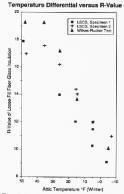 ORNL test on loose fill
Fiberglass attic insulation shows a loss in R value of as much as
50% for cold outside temperatures. This loss is due to convection
currents within the FG insulation. Cellulose insulation was also
tested, and does not show this loss. ORNL test on loose fill
Fiberglass attic insulation shows a loss in R value of as much as
50% for cold outside temperatures. This loss is due to convection
currents within the FG insulation. Cellulose insulation was also
tested, and does not show this loss.
|
| Cheating -- The Insulation Industry's
Dirty Secret
www.homeenergy.org/...
|
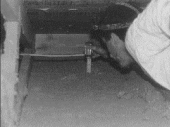 An article from Home Energy magazine on cheating in
the insulation industry. An article from Home Energy magazine on cheating in
the insulation industry.
Sad but important reading for everyone. This is a good reason
to 1) do it yourself, or 2) really understand what insulating is
about, and make sure the contractor knows that you will check on
his/her work.
|
| Insulation Under Concrete Slabs
www.blueridgecompany.com/ ... (pdf) (this link has gone
away)
Another test of slab insulation...
|
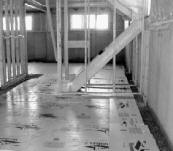 Good article on under slab
insulation for radiant heated floors. Good article on under slab
insulation for radiant heated floors.
Compares three types of insulation to no insulation.
Rigid foam insulations do well, but the bubble pack style of
insulation is worthless.
|
| Attic Tent
http://www.attictent.com/product.htm
|
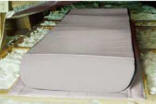 Pull down attic stairways
are notorious for air leaks. This $200 commercial product seals up
the attic stairway in what looks like an effective way. Pull down attic stairways
are notorious for air leaks. This $200 commercial product seals up
the attic stairway in what looks like an effective way.
It seems like a DIY version would also be possible. If you do a
home made one, please let
me know. Or, maybe you have an alternative way of sealing? |
| DIY version of "Attic Tent"
Details ...
|
 Here is an easy
to build means to cut heat loss through the pull down attic stairway
opening. Here is an easy
to build means to cut heat loss through the pull down attic stairway
opening.
Details ...
|
| Preventing Stratification
With High Ceilings
Heat Harvester:
www.sunpipe.co.uk
|
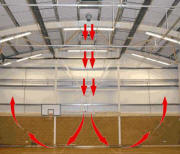 Homes or
buildings with high ceilings can result in lots of hot air near the
ceiling. The "Heat Harvester" (or a ceiling fan) can keep the air
mixed up and save some heat. Homes or
buildings with high ceilings can result in lots of hot air near the
ceiling. The "Heat Harvester" (or a ceiling fan) can keep the air
mixed up and save some heat.
Note that high ceilings don't always result in stratification, so
check to make sure you really need one of these here
... |
Insulating
Paint
http://www.greenbuildingadvisor.com/...
|
 Insulating
paint is a scam. If you need proof of this, read this article from
the Green Building Advisor site. Insulating
paint is a scam. If you need proof of this, read this article from
the Green Building Advisor site.
|
| Insulating
Window Treatments |
|
Making Your Own Interior
Storm Windows,
From Paul
Full Details ...
|
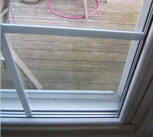 Paul provides a good
detailed set of instructions on how to design, build, and install
inside Acrylic storm windows. Paul provides a good
detailed set of instructions on how to design, build, and install
inside Acrylic storm windows.
|
| Multi-Wall
Polycarbonate Inside Storm Window
Gary
|
 These Multi-Wall
polycarbonate inside storm window panels offer high R values,
easy build, easy install, and are reasonable in price. Great for
windows of irregular shape. These Multi-Wall
polycarbonate inside storm window panels offer high R values,
easy build, easy install, and are reasonable in price. Great for
windows of irregular shape.
Full How-To instructions provided.
|
Building
Interior Window Insulation Panels,
from Guy Marsden's sustainable living website
www.arttec.net/Thermal-Windows/index.html
You can use this
calculator to see the payback period for these windows -- for me it turns out to be
about 3/4s or one heating season!
|
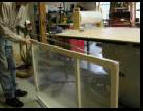 Very nice set of plans for double pane
interior storm window that can be made for about $1 per sqft. Very nice set of plans for double pane
interior storm window that can be made for about $1 per sqft.
As usual, Guy offers a very detailed and clear set of instructions.
These are somewhat similar to the ones I made from Mylar (just
below), so you can compare the two and see which will work best for
you.
|
| Dual
Pane Mylar Film Inside Storm Windows
How-To Picture Plans ...
Gary
|
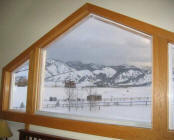 Picture plans for making an
dual pane inside storm window with an R value of 2. Picture plans for making an
dual pane inside storm window with an R value of 2.
The Mylar is quite clear, and the thermal performance with two
panes is about twice as good as a typical single pane storm
window.
Here is an example of a commercial kit to build a similar
dual layer interior storm window -- there may be many others.
About 5X the cost, but it looks like a good design.
NEW Life
of Mylar inside storm windows ...
|
| Simple,
Clear Acrylic Inside Storm Windows
Gary
|
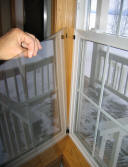 Very simple inside Acrylic
storm windows. Absolutely clear and non-distorting. Very simple inside Acrylic
storm windows. Absolutely clear and non-distorting.
They return 50%+ on your tax free, inflation protected
investment, and may qualify for rebates in your state. And, save
100+lbs of greenhouse gas emissions per year for a typical window!
NEW -- Large
window example...
|
| Plans Inside Storm Window
www.hammerzone.com
Another inside storm window how-to:
http://historichomeworks.com
|
 Plans for a simple inside
storm window made from poly film. Plans for a simple inside
storm window made from poly film.
Clear vinyl film might give a little more clear a
view.
Another film option would be the shrink film that a number of
companies sell for
inside storm windows. I understand that shrink film can
be purchased in bulk at artist supply places, and that the price
is much lower.
|
|
Simple,. Home-made, Low-cost and
Effectiv Insulating Curtains
www.kumeproject.com/
|
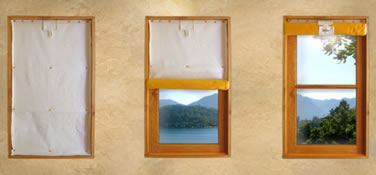 This is an easy build
and inexpensive four layer shade that provides good thermal
insulation for windows. It also addresses the condensation problem
that can occur with humid rooms and cold outdoor temperatures with
some thermal shades. This is an easy build
and inexpensive four layer shade that provides good thermal
insulation for windows. It also addresses the condensation problem
that can occur with humid rooms and cold outdoor temperatures with
some thermal shades.
The website gives very complete and clear instructions on how to
build the shades.
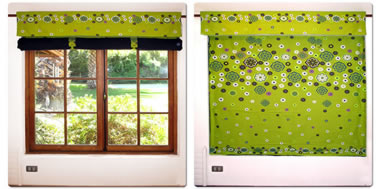
The shades are raised by rolling them up up to the top where they
are held in place by a built in band -- takes only a few seconds
The front layer of the shade can be as colorful as you like.
|
| Bubble
Wrap Window Insulation
Gary
New Installation Instruction
Sheet (8/15/06)
AND, The Card Board Shutter
Based on the popularity of this Bubble Wrap window
treatment, here is a Cardboard Shutter
|
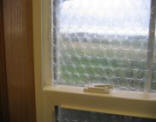 A really cheap and quick way
to insulate windows that you don't need a clear view out of. A really cheap and quick way
to insulate windows that you don't need a clear view out of.
Added some small updates to instructions 11/13/05.
Instruction sheet added 8/15/06
Reported life of bubble wrap added 2/27/07
 Another
cheap (but very effective) window insulator Card
Board Shutter --> Another
cheap (but very effective) window insulator Card
Board Shutter -->
|
| The half insulating shutter
-- light + insulation
Details...
|
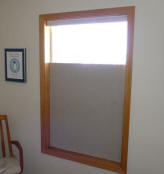 The idea is to put high Rvalue rigid
insulation foam board over part of the window while leaving the top
part uncovered to allow light in. The idea is to put high Rvalue rigid
insulation foam board over part of the window while leaving the top
part uncovered to allow light in.
It seems like this is a nice combination of light, view, and
insulation? Full length insulating shutters can still be used over
the panel at night. |
| Framed
and un-framed thermal shutters made from Astrofoil... |
  This
is quite a nice design for thermal shutters made from Astrofoil.
These shutters have reflective surfaces and both sides and provide a
high R value. This
is quite a nice design for thermal shutters made from Astrofoil.
These shutters have reflective surfaces and both sides and provide a
high R value.
The Astrofoil is stiff enough to fit into a window opening and
support itself without a frame. All
the details here... |
Top-down, Bottom-up
thermal shade insulates when part open
Details...
Note: the combination of double glazed low-e window + double Mylar
inside storm window + insulating shades with side tracks gives an R8.3
total for this window! |
 A
thermal shade that can be drawn from the bottom upward allows
lighting and some views out a window while still providing good
insulation for the part of the window that is covered. A
thermal shade that can be drawn from the bottom upward allows
lighting and some views out a window while still providing good
insulation for the part of the window that is covered.
It should perform similar to the Half Shutter listed just above.
Details... |
| FlipFlic -- KickStarter project to automate control
of thermal shades |
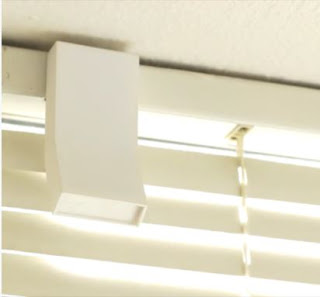 This innovative KickStarter project
automates the opening or closing of slat type blinds based on time
of day, room temperature, or light levels. This innovative KickStarter project
automates the opening or closing of slat type blinds based on time
of day, room temperature, or light levels.
It is simple to install, solar powered, and smartphone
controlled.
It looks like a simple way to save energy and eliminate the daily
ritual of opening and closing the blinds a couple times each day.
|
Insulating Shutter
Condensation Calculator,
Dave
Window Condensation Calculator ...
|
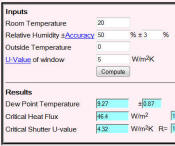 Loose fitting insulating window
treatments can lead to condensation buildup on the window. The
problem depends on room humidity, outside temperature, and the
window and insulating window treatment R values. Dave has worked
out a very nice Window
Condensation Calculator to determine if you are likely to
have a problem. Loose fitting insulating window
treatments can lead to condensation buildup on the window. The
problem depends on room humidity, outside temperature, and the
window and insulating window treatment R values. Dave has worked
out a very nice Window
Condensation Calculator to determine if you are likely to
have a problem.
Note that tight fitting insulating treatments that don't allow much
air circulation between window and treatment won't have this
problem. Thank you Dave! |
|
3M type shrink fit window films...
|
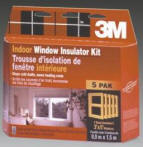 This window film is widely available at
hardware stores. You put double back tape (included) on the window
frame, then apply the film onto the tape, then use a hair dryer to
shrink it tight. This window film is widely available at
hardware stores. You put double back tape (included) on the window
frame, then apply the film onto the tape, then use a hair dryer to
shrink it tight.
In addition to adding about R1, it can be helpful in stopping
drafts. But, it is normally applied in such a way that you can't
open the window. Removing it will destroy it.
There is a very slight distortion of the view out the film. Cost is
about 30 cents/sqft. Life claimed is one year, but I think it will
go at least 2 if you leave it in place. |
| Insulating Window Quilt --
from the Econigics site
http://www.econogics.com/busys/wnquilt.htm
|
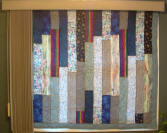 A simple DIY scheme for
making highly effective insulating window quilts. A simple DIY scheme for
making highly effective insulating window quilts. |
|
Thermal Cover-Ups: Part II
Mother Earth News
Finding
Mother Earth News articles...
|
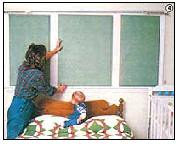 Mother Earth News Article,
Issue 85 Jan/Feb 1984 Mother Earth News Article,
Issue 85 Jan/Feb 1984
Good description of internal shutters made from foam board.
Be sure to consider the flammability of the materials that you
use for this project.
|
| $15 Rollup Insulating Window Shade ...
Doug Kalmer
|
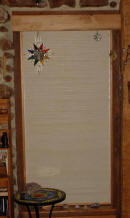 This is a
homemade thermal shade design that Doug Kalmer uses in his passive
solar home. This is a
homemade thermal shade design that Doug Kalmer uses in his passive
solar home.
The $15 rollup window shade made from Reflectix insulation.
How to make it...
See all of Doug's
solar projects ...
|
| An
Efficient and Simple Thermal Shade System... |
 Mike
uses a fleece curtain behind a regular curtain to increase the
insulating value with two layers. Mike
uses a fleece curtain behind a regular curtain to increase the
insulating value with two layers.
Details here... |
| Ray's Insulating Roman
Shades
Full Details ...
|
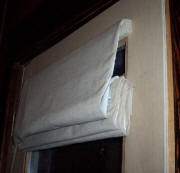 These insulating shades use
two outer layers of insulating fabric with a layer of reflective
aluminum spaced between. These insulating shades use
two outer layers of insulating fabric with a layer of reflective
aluminum spaced between.
They are reported to result in significant reduction in heating fuel
used, and they look good too.
(Thanks very much to Ray for providing the
details)
|
| High
R Value Inside Bi-Fold Shutters
Details ...
|
 Inside shutters that look
good and have a very high R value. Inside shutters that look
good and have a very high R value. |
| Warm
Window Insulating Shade System
www.warmcompany.com/
Very nice how-to guide to making their shades:
www.warmcompany.com/images/creative/window/sidedraw.pdf
|
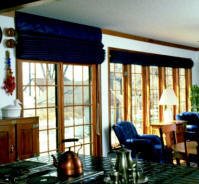 Warm Window offers thermal
shade material along with a number of products that are helpful in
making the shades. Warm Window offers thermal
shade material along with a number of products that are helpful in
making the shades.
The guide on making the shades appears to be very complete and
clear.
The guide claims an incremental R value of about +R6 for adding a
Warm Window shade -- even if this is exaggerated, it is very good
indeed. Magnetic strips make for good edge seals.
(Thanks to Angela for suggesting Warm Window. She
reports that the shades are easy to make, and work very well) |
| Insulating
Roman Shade
www.instructables.com/...
|
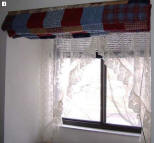 Nice set of plans from Instructables for
an insulating Roman Shade. Nice set of plans from Instructables for
an insulating Roman Shade. |
| Insulating
a Sliding Glass Door
Gary
|
 This describes an easy way to cut the
heat loss through a sliding glass door in half while still
maintaining the sliding door function. This describes an easy way to cut the
heat loss through a sliding glass door in half while still
maintaining the sliding door function.
The payback period in cold climates is about one half of a
heating season.
|
| Guides
to Selecting New or Replacement Windows |
If you are selecting windows for a new
house, or upgrading windows, take a look at this section.
|
| Thermal Shutters and Shades
William Shurcliff
See
Table of Contents and Some Sections
|
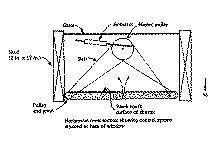 Thermal Shutters and Shades
-- Over 100 Schemes for Reducing Heat Loss Through Window.
Published in 1980, but still the best book on the subject. Out of
print, but available on BookFinders.com or Amazon.com used books (or
the like). Thermal Shutters and Shades
-- Over 100 Schemes for Reducing Heat Loss Through Window.
Published in 1980, but still the best book on the subject. Out of
print, but available on BookFinders.com or Amazon.com used books (or
the like). |
Seals:
Some Experimental Results,
Thermal Shutters and Shades,
William Shurcliff,
Details ... (pdf)
|
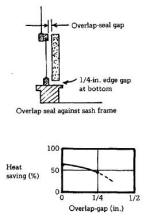 This is an
excerpt from the very good book Thermal Shutters and Shades, by Dr.
William Shurcliff This is an
excerpt from the very good book Thermal Shutters and Shades, by Dr.
William Shurcliff
He did some tests to determine how critical it is for insulating
shutters to fit the window precisely. He covers various
combinations of edge gaps and face gaps between the shutter and
the window.
The somewhat surprising result is that you can be a little bit
sloppy without effecting the performance of the insulating panel.
(thanks to Dr. Shurcliff for making this available)
|
| Keeping the pipes from freezing when away
Full
Details ...
|
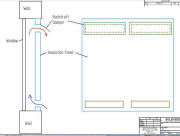 Several methods to keep the
pipes from freezing in your home or vacation home when you are away
without burning fuel. Several methods to keep the
pipes from freezing in your home or vacation home when you are away
without burning fuel.
Includes plug in window solar collector/insulator panels, and a
plumbing drain system, and others...
Full
details... |
| The Green Shutter -- for
summer sun control
http://www.inhabitat.com/2006/03/08/green-shutter/
From Inhabitat
|
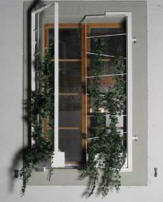 A pretty neat
design for a operable shutter with plants for sun control. A pretty neat
design for a operable shutter with plants for sun control. |
|
Air Infiltration Testing of Existing Double-Hung Window in an
Existing Urban Historic, Commercial, Mid-Rise Building,
Logan Cravens
http://www.portlandoregon.gov/bps/article/150881
I've always been a bit of a skeptic about the
benefits of sealing windows -- I go through the motions of
caulking and sealing, but unless the windows are really leaky how
do you know you've accomplished anything? This paper makes me
more of a believer that sealing can be well worth the time and
effort.
|
 Fascinating paper describing in field work done to
test for infiltration on existing windows in a Portland historic
building. Fascinating paper describing in field work done to
test for infiltration on existing windows in a Portland historic
building.
The test shows the test apparatus, and the results for the baseline
windows and the improvement for sealing (dramatic).
Its interesting that with some fairly simple sealing that very good
leakage rates were attained (equivalent to new windows). |
| |
|
| Window
Shading |
|
| Window Shading Scheme --
from the Econogics site
http://www.econogics.com/busys/shadecl.htm
|
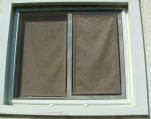 This is a pretty nice way to
provide shading of windows on the outside (where it is most
effective). The shade cloth is held in place with magnets and can
easily be removed. This is a pretty nice way to
provide shading of windows on the outside (where it is most
effective). The shade cloth is held in place with magnets and can
easily be removed. |
| Saving
Energy While You Sleep |
|
| Electric
Mattress Pad
Gary
|
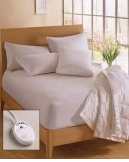 Electric mattress pads consume little
energy, and can allow substantial bedroom temperature setbacks. Electric mattress pads consume little
energy, and can allow substantial bedroom temperature setbacks.
Much more efficient than traditional electric blankets.
This has a payback of well under one year for us!
Full Story
|
| Sleep
Genie -- A sleep Compartment with AC
http://www.sunfrost.com/sleep_genie.html
From Sunfrost
You might combine the Sleep Genie with the
built in bed concept shown to the right (from Mother Earth
News)...
|
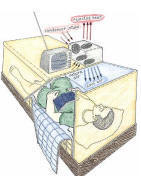 An interesting concept to
provide a comfortable, air-conditioned environment in a limited
space for sleeping comfort. An interesting concept to
provide a comfortable, air-conditioned environment in a limited
space for sleeping comfort. 
It saves the energy cost of needlessly air-conditioning a large
space when your are only occupying a small space.
|
Heating
Your Own Personal Space
Some times it just makes sense to heat your own
immediate personal space -- this can save a lot of energy and
result in increased comfort. |
| Kotatsu -- A Japanese
personal heater
http://en.wikipedia.org/wiki/Kotatsu
Making a Kotatsu...
|
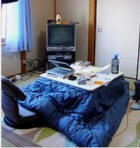 The Kotatsu is a low table with a heat
source mounted to the bottom surface of the table and aimed down. The Kotatsu is a low table with a heat
source mounted to the bottom surface of the table and aimed down.
You sit with legs under the table, and with a blanket or futon
covering your lower body.
It is said to keep your entire body comfortable even when the room
temperature is low.
(Thanks to Nick Pine for suggesting this)
I guess that having a small space heater under your desk is a less
refined variation on this. |
| Heated Clothes
One maker of heated clothing...
|
 These are one version of battery powered,
heated vests. The vest is made with very rine, flexible heating
wires through it. The heat from the vest keeps your core
temperature up, which convinces your god that it can maintain good
circulation to your extremities, and this makes you feel warm all
over even when the room is to cool for comfort. These are one version of battery powered,
heated vests. The vest is made with very rine, flexible heating
wires through it. The heat from the vest keeps your core
temperature up, which convinces your god that it can maintain good
circulation to your extremities, and this makes you feel warm all
over even when the room is to cool for comfort.
If you have had direct experience (good or bad) with
this or other heated clothing please
let me know... |
I
Cut 87% Off of My Electric Heat Bill
Reducing
heat use by 87% with personal space heating...
Video showing a live test of personal space
heating...
|
 This is a set of
techniques that concentrate on keeping just your personal space warm
while letting the room temperature drop much lower. For example, at
the computer, a dog heating pad is used to heat the feet, a light
bulb and reflector placed close is used as a radiant heater, and a
heated keyboard and heated mouse are used. A total of about 80
watts is used to keep the person at the computer very comfortable. This is a set of
techniques that concentrate on keeping just your personal space warm
while letting the room temperature drop much lower. For example, at
the computer, a dog heating pad is used to heat the feet, a light
bulb and reflector placed close is used as a radiant heater, and a
heated keyboard and heated mouse are used. A total of about 80
watts is used to keep the person at the computer very comfortable. |
| The ideas in the section
just above for sleeping also fall into this category.
Do you have any good techniques you use to keep your personal
space comfortable? Please
let me know...
|
The
Power Hogs
For most people, these will be things that use
the most power -- controlling them will cut most peoples
electricity use by half -- maybe more. |
|
The Power Hogs
The list to the right shows where most of your electricity goes.
Most
people can cut their household electricity use in half at a very
low cost, and with a very fast payback ...
Cutting electricity use of a typical US home in half saves:
- 6000 KWH a year
- $600 a year in electric bills
- 6 tons of CO2 emissions
|
Refrigerators -- Old ones (and
even not so old) can use over 1200 KWH a year.
A new energy star 20 cubic feet can use as little as 400 KWH per
year.
A saving of 800 KWH per year -- maybe more.
This
is what we saved ...
|
Computers -- A PC plus
peripherals can use over 1000 KWH a year.
It is very easy and cheap to cut this by 80%.
This is
what we saved ...
|
Lighting -- Changing to LEDs or
compact fluorescents can save over 1000 KWH per year.
This is what we saved ...
|
TIVO -- and TIVO like digital TV
recorders. These devices are always on and consume around 50 watts
24/7, or about 500 KWH per year.
There is a new energy star program coming out on these -- I'd hold
off and wait for Energy Star models.
|
TV's -- Some TV's can use as
much as 450 watts! At 8 hours of TV a day, this is 1300 KWH a year!
Use one of the lower power technologies (LCD or DLP). Look for OLED
TV's -- coming soon -- much lower power.
Article on this with power usage for many models ...
Selecting our new energy efficient TV... |
Washing and Drying -- A load of
cloths washed and rinsed in hot water, and then dried in an electric
dryer uses about 10 KWH! -- this is 3600 KWH a year at one load
per day. Most of this energy goes for heating water, and for
drying.
Use cold wash/cold rinse and a solar dryer (cloths line) to cut this
to near drastically. Front loading washing machines also help. |
Dumb Habits -- Just turning
things (lights, TV's, ...) off when you are not using them can save
several hundred KWH per year.
This
is what we saved ...
Get the kids involved ...
|
Swimming Pools and Hot Tubs
- If you have a swimming pool or hot tub, it will very likely be the
top consummer of electricity for your house. Just the pool pump can
consume thousands of KWH a year.
See the Solar Pool
Heating page for ideas on how to make your pool or tub more
efficient... |
|
Phantom Loads -- Many electronic gadgets (TV's,
entertainment centers, microwaves, chargers, ...) use power even
when switched off.
Electric coffee pots in "keep warm" mode use quite a bit of power
just keeping the coffee up to temperature -- switch to a thermos
type container to keep your coffee hot.
Here
is how to kill these power vampires ...
This can save you several hundred KWH per year.
Other (less well known) phantom loads
...
|
| More
Power Hogs -- some less common power hogs |
Radon Fans -- Radon mitigation
fans run 24/7 and can use up to 130 watts -- this could amount to
1100 KWH per year.
This artcle advocates trying a passive system first, and only
going to a fan system if Radon test levels come back high. Passive
systems can easily be converted to active systems. If an active
system is needed, I would always try a small fan first -- some are
as low as 40 watts. |
| Hot Water Recirculation Pumps --
These systems circulate hot water so that you always get instant hot
water even at taps very distant from the hot water heater. The
problem is that if you choose the wrong kind of installation they
can be horrible energy hogs --this
is our experience ... Would you believe $3200 worth of wasted
propane over 8 years? |
| Battery Powered Tool Chargers --
Battery powered tools come with a charger that most people just
leave plugged in all the time -- if you own several of the tools, these idle chargers can add up to a
significant phantom loads ... |
| "Half"
Project Electricity Saving Ideas |
These are the energy saving projects
that we used in cutting our electricity use in half.
You might be able to use some of the yourself. |
| Energy
Efficient Appliances |
|
| Energy Star
Energy
Star Ratings ...
|
Energy ratings and energy use for
appliances. Energy advice and online audit for homes. Energy
star appliances and homes.
In my view, the Energy Star program could be more aggressive, but
its certainly a good place to start.
|
The Energy Smart Kitchen,
Alex Wilson,
Fine Homebuilding Magazine, Issue 191, Oct 2007
How to
get articles from Fine Homebuilding ...
|
 A good Fine Homebuilding
Magazine article on how to choose energy efficient kitchen
appliances, and which cooking technologies are most efficient. A good Fine Homebuilding
Magazine article on how to choose energy efficient kitchen
appliances, and which cooking technologies are most efficient. |
| Some
Thoughts On Pilot Lights
|
 Some thoughts on the energy used by pilots
lights (surprisingly large), and how to reduce or eliminate this. Some thoughts on the energy used by pilots
lights (surprisingly large), and how to reduce or eliminate this.
And, a rather unusual strategy for heating your hot water with
just the energy from a pilot light.
|
Gas Pilot Light energy use
http://www.homeenergy.org
|
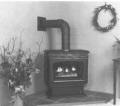 Article studying gas use by pilots on gas
fireplaces. A gas fireplace pilot (and probably other gas pilots)
use 7.3 therms of gas if left on all year, and almost 100 lbs of
greenhouse gas.(1) Article studying gas use by pilots on gas
fireplaces. A gas fireplace pilot (and probably other gas pilots)
use 7.3 therms of gas if left on all year, and almost 100 lbs of
greenhouse gas.(1)
Note that some sources report much higher gas use by pilots-- more
like 5 therms per month (1)
Turning off pilots on gas appliances that are not going to be in use
for a while would be a good way to save some energy and reduce
greenhouse has emissions.
(1) Home Energy Magazine has corrected the 7.3 to 73 therms
here...
(Thanks to Ned for finding this) |
Converting a chest freezer into a very efficient refridgerator
Several approaches to converting chest freezers into efficient
refrigerator:
This article is from the Mt Best -- Australia solar house site: http://mtbest.net/chest_fridge.html
A very interesting solar house with several unique features, and a
bit more info on the chest fridge.
The thermostat shown on this page is reported to allow you to use
a chest freezer as a refrigerator with large energy saving:
Beer
Fridge Thermostat
And, a digital one:
http://www.micromatic.com
|
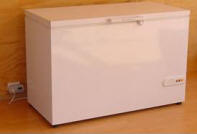 This refrigerator, which is a converted chest type
freezer uses only about 0.1 KWH per day (about 1/10th of good
conventional fridges!). See the article for details. Latest
update includes a design for a low standby power thermostat. This refrigerator, which is a converted chest type
freezer uses only about 0.1 KWH per day (about 1/10th of good
conventional fridges!). See the article for details. Latest
update includes a design for a low standby power thermostat.
Apparently not all chest freezers are created equal, as some do
not report quite as dramatic an energy saving as Tom reported in
his paper -- so if you are getting a new chest freezer for this,
pick an efficient one to start with.
One person reported 0.3 KWH per day (108KWH/year) on a newer
Kenmore freezer that was EPA rated at 279KWH per year. So,
something like a quarter of a typical, similar size conventional
(upright) refrigerator seems easily achievable.
One person reported using added thermal mass in the fridge on his
off grid system to allow the inverter to be turned off at night.
Some comments on converting chest
freezers to refrigerators....
|
| SunFrost Refrigerators
http://www.sunfrost.com/refrigerators_main.html
|
 I don't normally plug
commercial products, but the energy consumption of SunFrost is about
40% less than comparable new refrigerators from the GE's and others. I don't normally plug
commercial products, but the energy consumption of SunFrost is about
40% less than comparable new refrigerators from the GE's and others.
So, why can't GE do this?
EnergyStar Fridge Ratings
|
| Make a Fridge?
Description of the fridge making kit and instructions for making
a fridge from it ...
More Details (pdf)
Another kit fridge -- DIY System Kits:
www.rparts.com/index.php?cPath=84_14
|
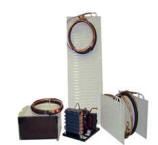 This is just a thought.
NovaKool (maybe others?) offers a kit for people who want to make
their own fridges. It consists of a compressor, evaporator,
condenser, controls, and pre-charged tubing -- all the guts of a
fridge. It is intended for boat or RV owners who want a built in
fridge. It uses the DanFoss compressor, which is reputed to be
efficient. This is just a thought.
NovaKool (maybe others?) offers a kit for people who want to make
their own fridges. It consists of a compressor, evaporator,
condenser, controls, and pre-charged tubing -- all the guts of a
fridge. It is intended for boat or RV owners who want a built in
fridge. It uses the DanFoss compressor, which is reputed to be
efficient.
If you wanted to make a very efficient fridge, this kit would allow
you allow you to build the box with as much insulation as you want,
it could be top opening, and the compressor could be located in an
optimal spot. On just a rough guess from their specs, you might get
down to 0.1 KWH per day for a very well insulated 8 cubic foot
fridge. Unfortunately the kit is not cheap, but this still might
pay well for off-grid PV users.
If anyone has tried this (or similar), please let me know how it
turned out --
Gary
Note -- see next entry for Ray's very nice example of using one of
these kits. |
| Build
DC Powered Refrigerator or Freezer!
Full Construction Details...
|
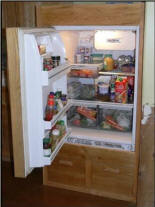 This is a really nicely done homemade
refrigerator that uses a refrigerator kit intended for custom
refrigerators on boats. This is a really nicely done homemade
refrigerator that uses a refrigerator kit intended for custom
refrigerators on boats.
Ray started with a 13 cuft conventional fridge. The existing
compressor/evaporator were removed, about 4 inches of rigid foam
insulation were added to the outside, then, an efficient DC
refrigeration unit (similar to the ones listed just above) is
installed to provide the cooling. The condenser coil and compressor
are located away from the fridge in the cool basement for more
efficient operation.
The fridge uses about 100 KWH per year -- about one quarter what an
Energy Start fridge of the same size would use!
This would make a very efficient off-grid refrigerator that could
run directly from the battery bank.
Ray has a lot of other interesting
projects on his site ... |
Hot Water, Cold Beer
Doug
|
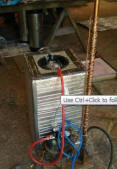 Doug's homemade heat pump that
efficiently cools his beer kegs and heats domestic hot water. Doug's homemade heat pump that
efficiently cools his beer kegs and heats domestic hot water.
Its a heat pump that pumps heat out of the beer and into the
domestic hot water tank.
All the details ...
|
| Cold Weather Passive Assist
Refrigerator
http://www.sunfrost.com/passive_refrig.html
|
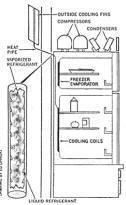 A refrigerator design that
takes advantage of cold outside air to reduce energy consumption. A refrigerator design that
takes advantage of cold outside air to reduce energy consumption. |
| Passive Refrigerator/Icebox
http://fourmileisland.com/IceBox.htm
Note: I am guessing there is a significant learning curve
attached to getting one of these operating well.
|
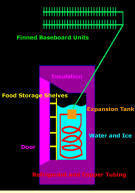 This frig uses a well insulated 300
gallon water/ice container that is cooled by an outdoor finned tube
baseboard unit to supply year round refrigeration with no energy
use. No moving parts. This frig uses a well insulated 300
gallon water/ice container that is cooled by an outdoor finned tube
baseboard unit to supply year round refrigeration with no energy
use. No moving parts.
Other interesting projects on the same site.
|
| A
More Efficient Shower
http://www.sunfrost.com/efficient_shower.html
|
 A shower idea that reduces
heat losses and air currents so that you can have a comfortable
shower with less water that is less hot. A shower idea that reduces
heat losses and air currents so that you can have a comfortable
shower with less water that is less hot.
Interesting story and prototype. |
Another More Efficient Shower Retrofit
|
 This
is Mike's idea for improving shower efficiency. It has similar
advantages to the entry just above, but is easier to retrofit and
probably aesthetically more pleasing. This
is Mike's idea for improving shower efficiency. It has similar
advantages to the entry just above, but is easier to retrofit and
probably aesthetically more pleasing.
Efficient shower details... |
| Drying Clothes |
|
|

Conventional clothes dryers are a major energy user in homes. A
Canada study shows that dryers typically use 930 KWH a year to do
416 dryer loads (2.23 KWH per load). Nearly all of this heat
energy simply expelled outdoors (wasted).
In addition, as the dryer vents air outside, fresh air is pulled
into the house to replace the vented air. This fresh air has to
be heated or cooled (depending on season) to room temperature --
this can easily add another 300 KWH plus per year. Its amazing to
me that this very large energy sink does not get more attention.
For many homes, the clothes dryer will be the largest consumer of
energy in the house after water heating. Here are some ways to
reduce energy use that goes into clothes drying.
September 2014: It appears that EPA is going to finally have an
Energy Star program for dryers. Expect to see a lot of work on
dryer design in the next few years to earn the Energy Star label.
|
| Ken's
Solar Clothes Drying Rack
Full detailed
pictures and plans for Ken's solar clothes drying rack ...
|
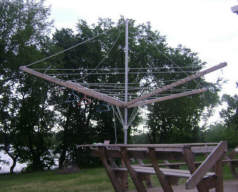 When Ken could not find a good clothes
drying rack at the local store, he set out to design and build his
own. When Ken could not find a good clothes
drying rack at the local store, he set out to design and build his
own.
He came up with a great design, and provides detailed pictures
and plans of the rack.
He includes plans for both a deck mounted rack, and for a ground
mounted design.
One of the really neat features is that you can hang clothes on
clothes hangers, and then hang the hangers right on the rack.
All the materials for the rack are easy to come by and locally
available.
|
| A
collection of cloths line ideas ...
|
 Drying clothes with a gas or electric
dryer is energy intensive. Here are some ideas on clotheslines and
other solutions. Drying clothes with a gas or electric
dryer is energy intensive. Here are some ideas on clotheslines and
other solutions.
Where, what kind, experiences, ... |
| Building A Cloths Drying Rack
http://www.handymanwire.com/articles/rack.html
|
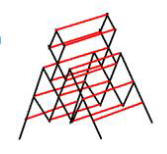 Plans for a simple wood
cloths drying rack. Plans for a simple wood
cloths drying rack.
Save about about 2.3 KWH per dryer load -- $90 and 1600 lbs of
CO2 per year.
|
| Solar Clothes Drying (the
clothesline)
http://www.burkesbackyard.com.au/ ...
|
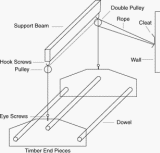 Plans for a clothes drying
rack that can be raised or lowered. Plans for a clothes drying
rack that can be raised or lowered. |
|
Umbrella Rack Style Cloths Dry
Hills Clothes Lines...
http://www.acehardware.com/...
|
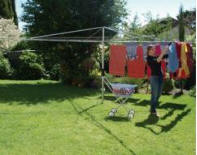 Several people have asked
about these, and they seem to be hard to locate -- so here is one.
Have no idea how good it is. Several people have asked
about these, and they seem to be hard to locate -- so here is one.
Have no idea how good it is.
Seems like one could build one?
|
Hogan Wood Clothes Drying
Rack
www.hoganwood.com
|
 Here is nice
commercial indoor drying rack that folds up against the wall when
not in use. Here is nice
commercial indoor drying rack that folds up against the wall when
not in use.
There is enough detail on the site to build one if you would rather
do that. |
Condensing
Dryers
A rundown on condensing dryers...
Energy stats for a number of condenser dryers... |
 Condensing
dryers do not vent the dryer exhaust outside. Instead, they run the
exhaust through a heat exchanger that condenses out the moisture,
and then circulates the now dry air back through the clothes. Condensing
dryers do not vent the dryer exhaust outside. Instead, they run the
exhaust through a heat exchanger that condenses out the moisture,
and then circulates the now dry air back through the clothes.
"How
much energy does it consume?
This will vary, depending on the size of
the machine and the load. The condensing dryer saves an enormous
amount of electrical energy by returning the already warm air to
the drum, requiring only a few degrees bump in temperature,
instead of heating room temperature air to the level needed to
dry the clothes. Conventional dryers exhaust 200 cubic feet of
air per minute from the residence, condensing dryers do not.
This is 10,000 cubic feet per cycle that does not need to be
heated or cooled to room temperature, an enormous saving in not
only residential utility costs, but in the stress placed on the
air intake systems of the building. "
There are several types of condenser dryers, and some do a better
job of saving energy than others. There are also differences in
drying performance. So, make a careful selection.
|
Converting a Clothes Dryer to Use Solar
Heated Attic Air
All the
details on Randy's solar dryer conversion... |
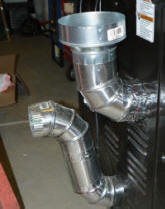 Randy
has worked out a way to convert a conventional d dryer so that
rather than using an internal heater to make hot air do dry the
clothes, he uses hot air produced by his unique solar attic
collector. Randy
has worked out a way to convert a conventional d dryer so that
rather than using an internal heater to make hot air do dry the
clothes, he uses hot air produced by his unique solar attic
collector.
This cuts the cost and energy use and CO2 emissions to do a dryer
load by a factor of five! |
| Venting the
dryer inside the house to recover the dryer heat |
A lot of heat is wasted by cloths dryers
that take house air, add energy to it, blow it through the cloths,
and then exhaust the heated air outside.
I have seen schemes that range from just venting the dryer to the
inside of the house with a nylon sock tied over the end for lint
control (dry climates only), up to the pretty exotic dryer
heat exchanger offered (in Europe) by Electrolux.
If you have tried a scheme (or have an idea for a scheme) to
extract dryer heat, I would like to hear about it (whether it
worked or not) Gary.
Update: This is the simple scheme we are now using to
recover heat from our dryer -- yearly saving is 630 KWH.
SAFETY NOTE: If you have a gas dryer, BE CAREFUL
with what you do with the exhaust, since it has combustion
products from the gas flame.
Also, be very careful to check for moisture
problems...
|
| Clothes Dry Heat Recovery Using a Furnace Filter for
Lint Removal... |
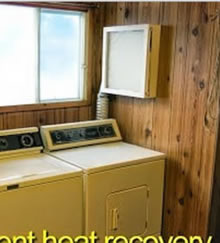 This is George Plhak's
scheme for venting the dryer inside. This is George Plhak's
scheme for venting the dryer inside.
It uses a box with an easily replaced furnace filter for the lint
filtering.
The furnace filter offers a lot of filter area, is inexpensive,
and easy to replace.
Be sure to read the SAFETY NOTE just above.
All the details...
|
| An
Experimental DIY Clothes Dryer Heat Recovery Heat Exchanger... |
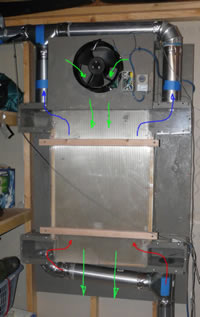 This is a prototype that
I did for a heat exchanger that recovers heat from the dryer
exhaust vent air stream. This is a prototype that
I did for a heat exchanger that recovers heat from the dryer
exhaust vent air stream.
Its a cross flow heat exchanger made from twinwall polycarbonate
glazing panels.
There are 14 layers of twinwall glazing that carry the hot dryer
vent air, while the room air passes through spaces between the
twinwall panels.
While I consider this experimental, it has performed well over a
couple of seasons.
|
Power
Saving Ideas
Some simple ideas that can save lots of power |
|
| Timers and Motion Switches
Details ..
Got any other ideas? -- please
send them in...
|
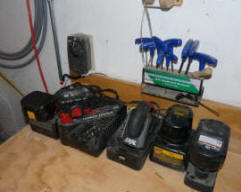 Some ways to use motion switches and
timers to save electricity and to foil your kids attempt to drive
you nuts by leaving stuff on all over. Some ways to use motion switches and
timers to save electricity and to foil your kids attempt to drive
you nuts by leaving stuff on all over.
Details ...
<-- Picture to left shows chargers on a timer
-- 170 KWH and 300 lbs of CO2 saving a year
|
| 24 Hour Timers to Turn Stuff
Off at Night (or whenever)
|
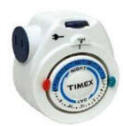 Use an inexpensive 24 hour timer to turn
off things that you don't want to run at night. Use an inexpensive 24 hour timer to turn
off things that you don't want to run at night.
You can also plug a power strip into the timer, and turn off
multiple items with one timer, or some timers have more than one
outlet.
Turning off 15 watts for 12 hrs a day, 365 days a year is worth 70
KWH -- about $7, and 140 lbs of CO2.
|
| Power Saving On Personal
Computers
Our
PC electricity savings ...
Table of
power consumption details, and procedure ...
Gary
A couple more ideas on reducing computer power on Ralph's
Energy Efficiency Blog...
|
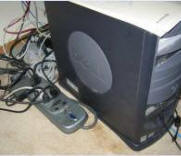 This details how we go about saving
electricity for the two PC's we have in the house. This details how we go about saving
electricity for the two PC's we have in the house.
This very simple procedure saves a staggering 1780 KWH per year
-- worth $178 and 3600 lbs of CO2.
I don't know of any other way to save this much electricity so
easily.
I think that one thing that people tend to overlook in managing PC
power use is that all the peripherals (printers, scanners, ...)
also use power -- in our case, more than the computer itself --
you have address this as well as the PC.
|
| Three Ways to Save Power On
Your PC
Mini Power Minder for PC's...
Smart Strip
www.cyberguys.com
Note: this one can also be used to control power to your whole
entertainment center, or any related group of electrical gadgets.
|
PC peripherals continue to draw power
after you turn your PC off. Use one of these devices to turn off
the power to all the PC peripherals automatically when your PC is
turned off.
 USB mini Power Minder. This device allows you to
automatically turn off all of your PC peripherals (printer,
scanner, ...) when you turn off the PC. USB mini Power Minder. This device allows you to
automatically turn off all of your PC peripherals (printer,
scanner, ...) when you turn off the PC.
$15
Available on Amazon etc.
Our test of the Mini Power Minder
...
----------------------------------- --------------------------------------- ---------------------------------------
Smart Strip -- turns off everything plugged into the power strip
when the item that is plugged into the "control" outlet (usually
your PC) is turned off. Keeps peripherals from drawing power when
the PC is off.
See picture just below in the next item.
Our test of the Smart Strip...
|
Power
Cost Monitor:
TED Power Monitor:
www.theenergydetective.com
And, another one:
www.inhabitat.com ,,,
|
Two Whole House Power Monitors:
Power Cost Monitor: 
These easy to install power meters tell you how much electricity
your house is using (and has used).
The idea being that getting instant feedback when you turn on
lights, appliances, ... will help you cut down on electricity use.
TED:
Note that while TED is more involved to install, it provides
faster response, optional software logging, and it can measure
individual circuits as well as the whole house.
(Thanks to Tom for finding the TED info)
|
| ECO Electric Tea Kettle
http://www.ecokettle.com/
Available under the toastess Brand in the US:
http://www.amazon.com
|
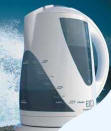 An electric tea kettle that boils exactly
as much water as you need -- not two or three times as much. An electric tea kettle that boils exactly
as much water as you need -- not two or three times as much.
It would be nice if more manufacturers paid attention to the details
like this -- it takes a lot of energy to boil water.
(thanks to Vanya for suggesting this)
If you avoid boiling 6 cups of water a day, this adds up to 1.2
KWH per day, or 430 KWH per year and 900 lbs of CO2 if your
electricity comes from a coal powered plant
Another idea on using a drip coffee
maker to make heat water for tea efficiently ... |
| Selecting
an Efficient TV
|
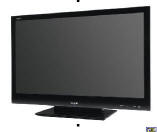 For families that watch TV, the TV can
end up using more energy than the "big" energy users like
refrigerators. For families that watch TV, the TV can
end up using more energy than the "big" energy users like
refrigerators.
This is a write-up on how we selected our
new TV along with some resources that are helpful in finding and
efficient one...
NEW! Starting in 2011, new TVs
will be required to have the Yellow Energy Guide labels -- this should be a big help in
shopping for an energy efficient TV.
Yellow Energy Guide labels -- this should be a big help in
shopping for an energy efficient TV.
|
| Phantom
Loads |
|
|
Phantom Loads radio interview on "Good Dirt Radio"
Hear the interview
...
|
 This is an interview with
yours truly that gives an overview of what phantom loads are, and
what you can do about them. See the material in the item below for
more details. This is an interview with
yours truly that gives an overview of what phantom loads are, and
what you can do about them. See the material in the item below for
more details.
The interview was one of many good stories and interviews from
the "Good
Dirt Radio". Thanks to Good Dirt producer Gary Lewin for
his good work on this.
|
| Eliminating Phantom
Electrical Loads
Eliminate
Phantom Load -- From the "Half" program...
Using a
Kill-A-Watt meter to find phantoms...
Phantom Load suggestions from Marc ...
The worst of the Phantom Loads ...
(really gross offenders)
|
 Many electrical gadgets (TV's, microwaves,
chargers, ...) continue to use power even after you turn them off.
This can be just a little or a surprisingly large amount. Many electrical gadgets (TV's, microwaves,
chargers, ...) continue to use power even after you turn them off.
This can be just a little or a surprisingly large amount.
The sad truth is that over their lifetime, many electronic devices
will consume more power during the times they are off than when on!
This costs of billions of dollars a year and lots of green house
gas.
The four items listed to the left provide some ways to identify
and eliminate these power sucking vampire loads.
It is difficult to take phantom loads into account when you buy
new electrical devices because the manufacturers don't provide
this information. One thing that would help is for all electrical
devices to include typical and phantom power use on the outside of
their packaging -- write to your legislator and suggest this!
Until we get this, I would suggest testing new gadgets with your
Kill-A-Watt meter when you get them home, and return anything that
uses too much power when off (or on) -- make sure the store and
the manufacturer know why you are returning it.
|
| Lighting
and Daylighting |
|
Lots more information
on efficient lighting and day lighting in our Lighting
Section...
|
 The section on
lighting provides more information on both day
lighting and efficient lighting design and projects... The section on
lighting provides more information on both day
lighting and efficient lighting design and projects... |
| Efficient Lighting
EERE on Types of Lighting
http://www.eere.energy.gov
This is our families estimated saving in energy and GHG's for
going to CFL's:
http://www.builditsolar.com
(A 224% return on investment, and 1 TON of CO2 per
year)
Efficiency of various types of lights ...
Instructables tutorial on using CFLs...
|
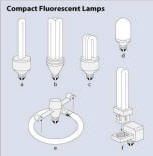 It is a just plain no-brainer to use
fluorescents and compact fluorescents. They are far more efficient,
last much much longer, and will save you a ton of money and
greenhouse gas emissions. It is a just plain no-brainer to use
fluorescents and compact fluorescents. They are far more efficient,
last much much longer, and will save you a ton of money and
greenhouse gas emissions.
Most utility companies offer some form of rebate program for buying
CFL's -- making it even more of a no-brainer!
Some have expressed concerns about the small amount of Mercury
contained in CF's and fluorescents. This does not appear to be
much of a concern, but have a look at the EPA fact sheet in case
you break one someday.
EPA fact sheet:
http://www.nema.org/lamprecycle/epafactsheet-cfl.pdf
Treehugger article:
http://www.treehugger.com
Another on Mercury:
Net effect of Mercury in CFs
|
| Giving LEDs a try in our house... |
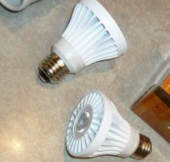 This is our experiment in
going to LED floods for our six track lights in the kitchen. This is our experiment in
going to LED floods for our six track lights in the kitchen.
There is a lot to learn in switching the LEDs, but the end result
can be very good.
Details...
|
|
An Easy/Good DIY LED Can Light Retrofit
All the details on
replacing can lights with LEDs...
|
 This is the latest
step in trying LEDs. This LED is designed as a retrofit for
regular can lights. This is the latest
step in trying LEDs. This LED is designed as a retrofit for
regular can lights.
It provides lots of warm light while using only 10.5 watts, and
claims a 20 year life.
The installation was easy, and offers the additional opportunity to
seal and insulate the can at the same time the LED is installed.
All the details on
replacing can lights with LEDs... |
The Best Compact Fluorescent
Light Bulbs: PM Lab Test,
Popular Mechanics Magazine
The PM Lab Test ... (page is not available anymore, but
results summarized to right)
|
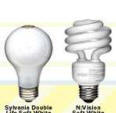 Popular Mechanics magazine did a careful
side by side comparison of a standard incandescent light bulb to
seven compact fluorescents. Popular Mechanics magazine did a careful
side by side comparison of a standard incandescent light bulb to
seven compact fluorescents.
They compared color temperature, color, brightness, face color, and
reading. The result was that ALL 7 CFL's SCORED HIGHER THAN
THE INCANDESCENT.
This should satisfy anyone's doubts about the light quality of
CFL's. |
| Daylighting
|
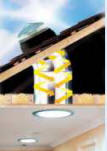 Using daylighting not only provides
better and more pleasant lighting, it saves energy and greenhouse
gas emissions. Using daylighting not only provides
better and more pleasant lighting, it saves energy and greenhouse
gas emissions.
Some daylighting solutions...
|
| LED Holiday Lights
Almost all of the usual places that sell holiday lights now sell
the LED lights. Prices still vary a lot. We got ours a Costco
for about $10 per string.
|
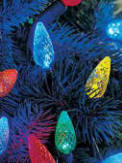 LED holiday lights are safer
(no heat), last a very long time, and look great. They also use
much less energy and significantly reduce greenhouse gas emissions.
The energy saving can be 90% or more. LED holiday lights are safer
(no heat), last a very long time, and look great. They also use
much less energy and significantly reduce greenhouse gas emissions.
The energy saving can be 90% or more.
A typical 100 light LED string uses less than 4 watts! They have
an expected lifetime of 20+ years. With the LED holiday light
prices dropping, the payback period can be as small as a season or
two (considering both lower operating cost and longer life).
|
| Hot
Water Recirculation Systems |
|
|
Hot Water Recirculation systems
|
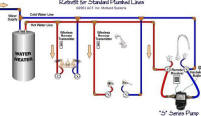 These systems get around the
problem of having a long wait for hot water, but can be very
very wasteful of energy. These systems get around the
problem of having a long wait for hot water, but can be very
very wasteful of energy.
Details here ...
|
|
Installing an On-Demand hot water recirculation system
http://www.arttec.net/SolarDHW/Dmand-Pump/
|
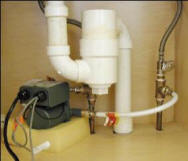 Guy Marsden describes the
installation of his efficient hot water recirculation system. Nice
detailed how-to. Guy Marsden describes the
installation of his efficient hot water recirculation system. Nice
detailed how-to.
These systems use much less energy and water than systems that
circulate 24/7, or systems that uses a timer or aquastat to
control recirculation.
|
| Gray
Water Heat Exchanger |
|
| GFX Gray Water Heat Exchanger
www.gfxtechnology.com/
DOE Inventions & Innovations report:
DOE report on GFX
(pdf)
Another Brand:
http://www.renewability.com/powerpipe.htm
And another:
http://www.retherm.com/
And another:
http://www.ecodrain.ca/
|
 A well designed gray water heat exchanger
can recover a large fraction of the heat that would normally go down
the drain in your shower, and some other hot water uses. A well designed gray water heat exchanger
can recover a large fraction of the heat that would normally go down
the drain in your shower, and some other hot water uses.
In a normal shower, you spend a lot of energy heating water from
50F or so up to 100F. It flows out the shower nozzle, over your
bod, and down the drain taking 95% or so of the energy you just
spent heating it. The gray water heat exchanger uses the heat in
the drain water to heat the incoming water.
|
|
DIY
Grey Water Heat Exchanger for Showers...
|
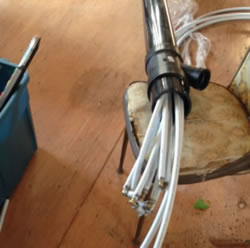 This is a simple and
effective grey water heat exchanger from Tyler that captures some
of the heat from your shower drain water in order to preheat water
on its way to the shower. This is a simple and
effective grey water heat exchanger from Tyler that captures some
of the heat from your shower drain water in order to preheat water
on its way to the shower.
|
Drain
Water Heat Recovery - Energy Savings Calculator,
from CEATI
Drain Water Heat
Recovery Calculator...
Report on the testing program the calculator is based on:
http://www.cmhc.ca/odpub/pdf/65680.pdf
|
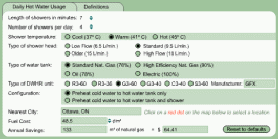 A calculator to estimate the energy
savings for installing a gray water heat exchanger. A calculator to estimate the energy
savings for installing a gray water heat exchanger.
While the calculator only lists Ca cities, you can pick one with
about the same ground water temp as your area. |
| Landscaping
For Energy Efficiency |
|
| Planning Tree Windbreaks in
Missouri
University of Missouri Extension:
http://muextension.missouri.edu
Purdue University Extension:
www.ces.purdue.edu/extmedia/FNR/FNR-38.pdf
|
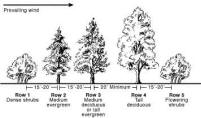 Planting trees
for a windbreak to protect house of livestock (or you) from wind. Planting trees
for a windbreak to protect house of livestock (or you) from wind. |
| Landscaping for Energy
Efficiency
Energy-Saving
Landscaping for Your Passive Solar Home, NC Solar Center
(pdf)
www.sustland.umn.edu/design/energysaving.html
http://www.eere.energy.gov
|
 Information on landscaping
for energy efficiency. "Carefully positioned trees can save up to
25% of household's energy consumption". Information on landscaping
for energy efficiency. "Carefully positioned trees can save up to
25% of household's energy consumption".
|
| Less
Stuff |
|
| Waste less food -- big
payoff!
www.treehugger.com/files/2008/02/sweden_says_eat.php
|
 Growing food and getting it to your
table accounts for about 20% of total GHG emissions. Growing food and getting it to your
table accounts for about 20% of total GHG emissions.
So, anything you can do to use less food and avoid wasting food has
a direct and significant impact on GHG emissions all the way down
the grow it, harvest it, transport it, prepare it, ... chain.
This is another one of those win-win areas where cutting down on
waste saves GHG's and dollars.
"Swedish life-cycle studies that show tossing one
serving of beef wastes enough energy to drive a low-energy light
bulb 163 hours" |
|
Human Power
|
|
| Pedal Power
Campus Center for Appropriate Technology
www.humboldt.edu/~ccat/pedalpower/frames.html
|
 Plans and concepts for a
variety of human powered appliances, tools, TV's, ... Plans and concepts for a
variety of human powered appliances, tools, TV's, ...
Lots of good ways to get some exercise!
Here is a sample: Pedal
Washer
|
| Bicycle Powered Generator
http://www.mattshaver.com/bikegen/index.htm
|
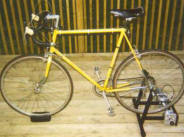 Instructions on how to make a bicycle
powered generator from a training stand. Instructions on how to make a bicycle
powered generator from a training stand.
Also includes information on what kinds of electrical loads can be
powered. |
| PPPM (Pedal Powered Prime
Mover)
http://www.los-gatos.ca.us
|
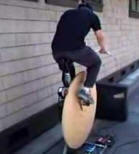 This is an interesting website that
provides information on pedal powered generators. Includes
information on building, what can be powered, and the use of
ultra-capacitors to smooth power output from the generator without
using batteries. This is an interesting website that
provides information on pedal powered generators. Includes
information on building, what can be powered, and the use of
ultra-capacitors to smooth power output from the generator without
using batteries. |
The Pedal-A-Watt
Stationary Bike Power Generator
http://www.econvergence.net/electro.htm |
 This is a
commercial version of a pedal powered generator that uses your
bike. Various accessories available to charge batteries etc. This is a
commercial version of a pedal powered generator that uses your
bike. Various accessories available to charge batteries etc.
The Testimonials section is interesting. |
Nice
setup for hand washing the laundry
www.youtube.com/watch?v=vUqACGizd30
|
 Short
YouTube video showing a nice simple and efficient setup for hand
washing and drying clothes. Short
YouTube video showing a nice simple and efficient setup for hand
washing and drying clothes.
Quick and easy. |
|
The James Hand Washer
At Lehmans
site, search for "hand clothes washer" -- they have
several...
Berry
Hill human powered washers...
|
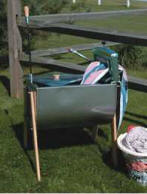 Person powered washers,
clothes drying hardware, and other interesting stuff. Person powered washers,
clothes drying hardware, and other interesting stuff. |
| Wonder Washer
www.laundry-alternative.com/wonderwash.htm
(this link may be broken Jan 20, 08)
http://www.treehugger.com/files/2005/07/qa_electricity.php
|
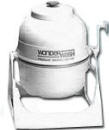 A simple, hand powered
washer that people seem to like. A simple, hand powered
washer that people seem to like. |
| "Yukon Plunger" washing
"machine"
http://www.wisementrading.com/washing.htm
|
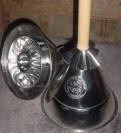 A even simpler arm powered
washing "machine". It would be pretty easy to just make one
yourself. A even simpler arm powered
washing "machine". It would be pretty easy to just make one
yourself. |
| Fran's
very simple DIY washer from a bucket
How to build it...
|
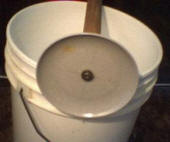 Fran made a very effective washer using a
5 gallon bucket, a length of dowel, and an old plastic plate. Fran made a very effective washer using a
5 gallon bucket, a length of dowel, and an old plastic plate.
Takes about 15 minutes and works well!
All the details ...
|
|
http://homelessdave.com/hdwashingman.htm
|
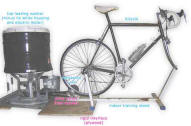 Quite an interesting article and plans
for a bicycle powered spin water extractor for cloths washing. Quite an interesting article and plans
for a bicycle powered spin water extractor for cloths washing. |
|
Cyclean -- Pedal Powered Washer/Dryer
http://cyclean.biz/mainmenu.html (this link not working now)
The Wayback Machine has this snapshot of the
project...
|
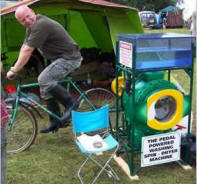 Get exercise and do the wash at the same
time. Get exercise and do the wash at the same
time.
Plans to make one are promised -- its says.
|
Other Conservation Related Areas on Build-It-Solar
There are lots of other areas on BIS that deal
with conservation and energy efficiency -- here are a few... |
|
The Water Section
|
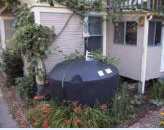 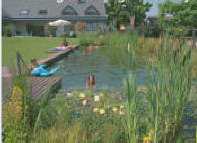 
Water conservation, grey water reuse, efficient toilets ...
|
| Energy
Conservation in Pool Heating
|
 Energy conservation in pool
heating. Pool covers, efficient pumps and circulation schemes, ... Energy conservation in pool
heating. Pool covers, efficient pumps and circulation schemes, ... |
| Efficient
lawn mowers and garden tractors |
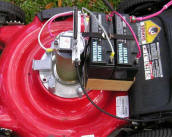 Electric lawn mowers and
tractors. Electric lawn mowers and
tractors.
Gas mowers pollute way out of proportion to their size -- here is
a way to get rid of yours.
|
Earth Notes: Saving
Electricity
How we got from 33kwh per day to 7kwh per day
http://www.earth.org.uk/saving-electricity.html
|
 Good conservation story on
drastically reducing electricity use without pain. Good conservation story on
drastically reducing electricity use without pain.
Points out the big saving that can occur from controlling computer
power consumption.
(Thanks to Damon for suggesting this)
|
|
Efficient Vehicles |
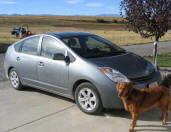 For many of us, choosing a
fuel efficient vehicle will save more energy than any other step we
can take. For many of us, choosing a
fuel efficient vehicle will save more energy than any other step we
can take. |
|
More here -- Build-It-Solar Central
|
"I
Did It" stories
A few energy saving success stories -- if you
have one, please send it in. |
| Our
own "1/2" Program
Gary
|
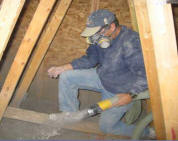 This is my families program
to see if we can reduce our total energy consumption and green house
gas emissions by one half. This is my families program
to see if we can reduce our total energy consumption and green house
gas emissions by one half. |
| Guy Marsden -- Sustainable
Living
www.arttec.net/SustainableLiving/index.html
|
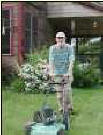 A very nice personal site
with Guy's program for saving energy and a more sustainable
lifestyle -- all very well explained. A very nice personal site
with Guy's program for saving energy and a more sustainable
lifestyle -- all very well explained.
Several good DIY solar energy projects with very good detial. |
My
Half Project
http://bryantbay2.blogspot.com/
|
 This
is a great blog by Dave, which I'm happy to say was in part inspired
by our own Half Program. This
is a great blog by Dave, which I'm happy to say was in part inspired
by our own Half Program.
There are many very good posts on the blog covering a variety of
energy saving techniques. The site is particularly strong on
various techniques for monitoring energy use of all sorts and on
keeping good records to actually see what is working. |
The Phantoms I've Killed...
Do the Math blog, Tom Murphy
|
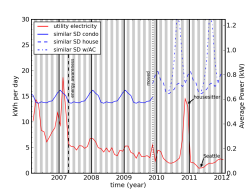 Very good rundown
by Physicist Tom Murphy describing how they cut electricity usage
down by a factor of 10 compared to a typical home in their area. Very good rundown
by Physicist Tom Murphy describing how they cut electricity usage
down by a factor of 10 compared to a typical home in their area.
Tom not only says what he accomplished, but also describes the tools
you can use to cut your electricity use.
(Thanks to Dave for finding this) |
| Kootenai
River Campground -- Energy Overhaul
All
the details on the energy overhaul...
|
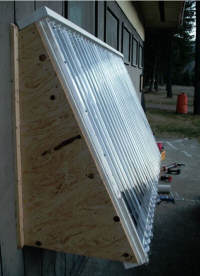 The Green Campground Blog
goes over the steps that they have taken at the Kootenai River
Campground to reduce energy consumption. The Green Campground Blog
goes over the steps that they have taken at the Kootenai River
Campground to reduce energy consumption.
They did a nice, systematic approach involving more insulation,
better doors, inside storm windows, solar water heating (using our
$1K system), efficient lightings, and more efficient
appliances. They have still more things on the list to do yet
-- next up is efficient shower heads. 
The campground is located in western Montana.
|
Thriving On Low Carbon...
Marc Rosenbaum
|
 Very good blog by
Marc Rosenbaum on all sorts of aspects of living a lower carbon
lifestyle. Very good blog by
Marc Rosenbaum on all sorts of aspects of living a lower carbon
lifestyle.
Interesting and effective projects with good details on the
implementation.
Well worth following. |
| Energy
and Solar Advice from Tom Gocze
American
Solartechnics...
|
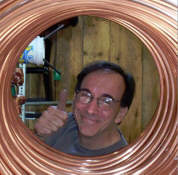 Tom Gocze is a genuine
expert on solar and renewable energy. He has been involved in the
solar business as a tank manufacturer 30+ years, and has done
applied renewable energy research in many areas. He also does a
radio show and a newspaper column on energy. Tom Gocze is a genuine
expert on solar and renewable energy. He has been involved in the
solar business as a tank manufacturer 30+ years, and has done
applied renewable energy research in many areas. He also does a
radio show and a newspaper column on energy.
This
link is to some of the columns he has done for the Bangor Daily
News and Hot and Cold TV. The advice he gives is honest,
technically correct, and pragmatic -- quite a relief given all the
BS out there on renewable energy. The columns are well worth
taking a few minutes to read.
|
| Good News: Average Family
Cuts Home Electric
Usage in Half
Full Story ...
|
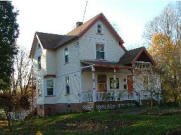 This letter describes how Ed
cut his families use of electricity in half over just 2 months. He
used a number of techniques, including an energy audit, eliminating
phantom loads, and just paying more attention to turning things off. This letter describes how Ed
cut his families use of electricity in half over just 2 months. He
used a number of techniques, including an energy audit, eliminating
phantom loads, and just paying more attention to turning things off.
Way to go Ed! Full
Story ...
"I actually stopped moaning about the rates for
5 minutes and did something to reduce my electric usage."
|
The Carbon Buster's Home
Energy Handbook,
Godo Stoyke, 2007
Available from New
Society Publishers...
|
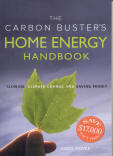 This is a brand
new and good book on how to start your own energy saving program
that will cut your energy use and green house gas emissions by as
much as 70% -- and save you $17,000 over 5 years. This is a brand
new and good book on how to start your own energy saving program
that will cut your energy use and green house gas emissions by as
much as 70% -- and save you $17,000 over 5 years.
The author lists many potential projects in all areas of energy use,
and provides cost, rate of return, energy saving and carbon saving
for each. It is done very much like my Half program listed above --
highly recommended.
Available at the usual book places $13. |
Solar Electricity at
Home...,
Kevin Johnson
How to get articles from
Home Power ...
www.HomePower.com
|
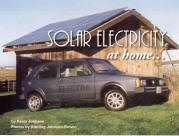 Home Power
magazine article, issue 117. Home Power
magazine article, issue 117.
This is quite an amazing story. Kevin details how his family has 1)
cut their transportation energy use to about 5 KWH per day by using
an electric vehicle conversion, and 2) their home electricity use to
about 5 KWH per day through conservation.
All of this energy is supplied by all of this energy is supplied by
a 2.9 KW grid tied PV system. |
| Iver's Energy Saving Projects
http://www.msad54.org
|
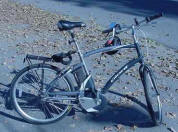
This is a good rundown on a set of energy saving projects that
Iver did. They are all fairly simple, but they really add up.
Iver recently estimated that his energy saving per year come up
to $3018 per year at today's energy prices!
|
| "Lazy" approach to
conservation still works
http://cameronmiller.net/energy-savings/
|
 Cameron describes his "lazy" approach to
energy conservation. Cameron describes his "lazy" approach to
energy conservation.
The approach may be lazy, but his gas bill is still down about
40%!
|
| Audited by Power Company for
Low Power Use
www.csmonitor.com/2006/1130/p13s01-sten.html
|
When Ray Janke took some simple steps to
reduce his electricity consumption, the power company audited him
because they thought he might be bypassing the meter.
Wouldn't that be a nice audit to go through :)
|
Full Energy Efficiency
Farmhouse Renovation
Mike Rogers
Home Energy Magazine
http://homeenergy.org
|
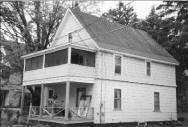 Article describes a well thought out
renovation of a 1920's farmhouse for energy efficiency. Article describes a well thought out
renovation of a 1920's farmhouse for energy efficiency.
The house posed several difficult to overcome problems in
retrofitting insulation.
Includes a fairly detailed description of a technique for installing
exterior wall insulation. |
| 800 to 80 kwh in four months
http://www.rmfdevelopment.com/energysa.html#littlemoney
|
A great story on how one couple reduced
their electric bill dramatically, along with quite a bit of detail
on the methods used.
Ryan has since moved to WA state, and is writing an account of
overhauling his home into an energy efficient home. |
The Land of Rising
Conservation,
NY Times
http://www.nytimes.com
|

Good NY Times article explaining why per household energy
consumption in Japan is less than half the US. |
| Saving Electricity Site --
Succes Stories
http://michaelbluejay.com/electricity/fanmail.html
|
There are some good stories on this
page, with some good and specific suggestions.
Its a good all around site on understanding how to save
electricity.
|

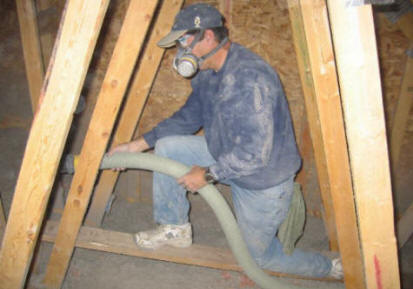
 A Do-It-Yourself home energy
audit
A Do-It-Yourself home energy
audit
 A cute new tool from Energy Star that identifies
energy saving tips on a room by room basis.
A cute new tool from Energy Star that identifies
energy saving tips on a room by room basis.  "Energy Savers" for home owners
(insulation, appliances, lighting, ...) energy saving advice.
"Energy Savers" for home owners
(insulation, appliances, lighting, ...) energy saving advice.
 These are good, practical guides on
energy saving that (I believe) exhibit a high level of technical
accuracy (a rarity), and can provide good guidance on which energy
saving changes are most cost effective. The guides are very
straightforward and readable. There are other places that offer
more detailed information on every subject, but this is a really
good place to start.
These are good, practical guides on
energy saving that (I believe) exhibit a high level of technical
accuracy (a rarity), and can provide good guidance on which energy
saving changes are most cost effective. The guides are very
straightforward and readable. There are other places that offer
more detailed information on every subject, but this is a really
good place to start. A helpful and easy to use Energy Star
calculator you can use to see how your homes energy efficiency
compares to others in your area.
A helpful and easy to use Energy Star
calculator you can use to see how your homes energy efficiency
compares to others in your area. Two helpful
items from the Energy Star website:
Two helpful
items from the Energy Star website: Very handy
calculator for estimating gas use as cost for the common gas
appliances.
Very handy
calculator for estimating gas use as cost for the common gas
appliances. This is a good
site on saving electricity. It provides in depth information on
what uses electricity, how much it uses, ideas for saving, and good
ways to estimate how much you will save for each idea.
This is a good
site on saving electricity. It provides in depth information on
what uses electricity, how much it uses, ideas for saving, and good
ways to estimate how much you will save for each idea. This is very
easy to use, yet very capable simulation software for estimating the
energy/thermal performance of a passive solar or conventional home.
Weather files for over 500 worldwide locations. It can be used to
evaluate the benefits of adding insulation or other energy
conserving features. Its a free download.
This is very
easy to use, yet very capable simulation software for estimating the
energy/thermal performance of a passive solar or conventional home.
Weather files for over 500 worldwide locations. It can be used to
evaluate the benefits of adding insulation or other energy
conserving features. Its a free download. EFI supplies a wide variety
of energy conservation products at what appear to be reasonable
prices -- including this "Comfy Critter Draft Dodger".
EFI supplies a wide variety
of energy conservation products at what appear to be reasonable
prices -- including this "Comfy Critter Draft Dodger".  A personal site with many
interesting articles on a wide range of conservation, efficiency,
green house gas, and solar projects. And, a discussion forum.
A personal site with many
interesting articles on a wide range of conservation, efficiency,
green house gas, and solar projects. And, a discussion forum. Calculate
how much money and greenhouse gas you would save with various
insulation, window, or window treatment upgrades.
Calculate
how much money and greenhouse gas you would save with various
insulation, window, or window treatment upgrades. This is a very well done guide to sealing up air
leaks in your home. Lots of good how-to pictures.
This is a very well done guide to sealing up air
leaks in your home. Lots of good how-to pictures.  Very, very good book on techniques for
improving home insulation, reducing air infiltration, and sealing
ductwork. The most complete and technically correct reference I
have found.
Very, very good book on techniques for
improving home insulation, reducing air infiltration, and sealing
ductwork. The most complete and technically correct reference I
have found. Fine Homebuilding Magazine,
Nov 2007, Issue 190. A good article by Bruce Harley (author of the
book just above) about finding and fixing particularly bad energy
wasting defects in your house.
Fine Homebuilding Magazine,
Nov 2007, Issue 190. A good article by Bruce Harley (author of the
book just above) about finding and fixing particularly bad energy
wasting defects in your house. This is a good and
up-to-date series of guides from DOE-EERE site for building an outer
shell on your home that minimizes heat transfer.
This is a good and
up-to-date series of guides from DOE-EERE site for building an outer
shell on your home that minimizes heat transfer. Some insulating
materials have large global warming impacts because of the blowing
agent used to make them.
Some insulating
materials have large global warming impacts because of the blowing
agent used to make them.  This is a good
article by Laren Corie in the Aug 2005 issue of the ESSN Newsletter.
This is a good
article by Laren Corie in the Aug 2005 issue of the ESSN Newsletter. Some collected
information on how-to blow insulation into your existing walls.
Some collected
information on how-to blow insulation into your existing walls. Good
article from the JLC giving the details on wet spray cellulose for
walls. This technique has become quite popular with professional
installers and offers many advantages over fiberglass batts.
Good
article from the JLC giving the details on wet spray cellulose for
walls. This technique has become quite popular with professional
installers and offers many advantages over fiberglass batts. A
good guide on installing fiberglass batt insulation with lots of
information on how to handle all the issues of fitting the batts
around objects and into odd places.
A
good guide on installing fiberglass batt insulation with lots of
information on how to handle all the issues of fitting the batts
around objects and into odd places. A good blog on the Green
Building Advisor blog on the do's and don'ts of insulating a
concrete basement wall.
A good blog on the Green
Building Advisor blog on the do's and don'ts of insulating a
concrete basement wall.  This
is our homemade blower door that uses a furnace blower for the fan.
This
is our homemade blower door that uses a furnace blower for the fan. and the methods you can use to compare
your house tightness to others as well as estimate the heat loss and
carbon emissions associated with infiltration.
and the methods you can use to compare
your house tightness to others as well as estimate the heat loss and
carbon emissions associated with infiltration. This is a set of plans
from the North Dakota State University extension for a DIY blower
door.
This is a set of plans
from the North Dakota State University extension for a DIY blower
door. Energy Star
resource page on duct sealing. Fforced air duct systems often show a
30% loss in heating and cooling efficiency due to duct leaks and
poor duct insulation is typical.
Energy Star
resource page on duct sealing. Fforced air duct systems often show a
30% loss in heating and cooling efficiency due to duct leaks and
poor duct insulation is typical.  Heating or cooling ducts
running through the attic can be large energy consumers compared
to ducts run within the conditioned space.
Heating or cooling ducts
running through the attic can be large energy consumers compared
to ducts run within the conditioned space. This is a process for
sealing ducts that works for the inside. It will reach areas of the
duct system that are built into walls or otherwise inaccessible.
This is a process for
sealing ducts that works for the inside. It will reach areas of the
duct system that are built into walls or otherwise inaccessible.  This is quite a
detailed and helpful guide on how to seal various joints and
penetrations.
This is quite a
detailed and helpful guide on how to seal various joints and
penetrations.
 Home Energy
Projects -- Good, detailed guide on DIY energy conservation
projects. Written for Alabama, but many projects are good for
anywhere.
Home Energy
Projects -- Good, detailed guide on DIY energy conservation
projects. Written for Alabama, but many projects are good for
anywhere.
 Mother Earth
News Article, Issue 194
Mother Earth
News Article, Issue 194
 A Fine Homebuilding article
explaining the two type of spray foam insulation.
A Fine Homebuilding article
explaining the two type of spray foam insulation. Mother Earth News Article,
Issue 153
Mother Earth News Article,
Issue 153 Good, detailed
guide on sealing houses to reduce air infiltration.
Good, detailed
guide on sealing houses to reduce air infiltration.
 A good and detailed guide on
sealing to reduce air infiltration.
A good and detailed guide on
sealing to reduce air infiltration.
 A good article from Fine
Homebuilding on adding insulation to the attic. Lots of emphasis
and detail on sealing before insulation, which is very important --
careful sealing of air leaks may save more energy than the
insulation.
A good article from Fine
Homebuilding on adding insulation to the attic. Lots of emphasis
and detail on sealing before insulation, which is very important --
careful sealing of air leaks may save more energy than the
insulation.
 The blower door test we had
recently showed a lot of infiltration through our pet door.
The blower door test we had
recently showed a lot of infiltration through our pet door.
 Fine Homebuilding article
shows a design for a double door access into the attic.
Fine Homebuilding article
shows a design for a double door access into the attic.
 Good fact sheet on what to
do about wet attics and ice dams.
Good fact sheet on what to
do about wet attics and ice dams. This is a
detailed and well written set of instructions on how to install a
radiant barrier.
This is a
detailed and well written set of instructions on how to install a
radiant barrier. Good guide on
how blower door testing and duct blast testing can be used to test
for the level of air infiltration your house if experiencing.
Good guide on
how blower door testing and duct blast testing can be used to test
for the level of air infiltration your house if experiencing. Closed
(unvented) crawl spaces can reduce heat loss, but have to be done
correctly. This site has lots of detailed information on how to
decide on whether to close your crawl space, and how to do it.
Closed
(unvented) crawl spaces can reduce heat loss, but have to be done
correctly. This site has lots of detailed information on how to
decide on whether to close your crawl space, and how to do it.
 A way to
retrofit a high R value, low thermal bridging, and high infiltration
resistance wall.
A way to
retrofit a high R value, low thermal bridging, and high infiltration
resistance wall.
 ORNL test on loose fill
Fiberglass attic insulation shows a loss in R value of as much as
50% for cold outside temperatures. This loss is due to convection
currents within the FG insulation. Cellulose insulation was also
tested, and does not show this loss.
ORNL test on loose fill
Fiberglass attic insulation shows a loss in R value of as much as
50% for cold outside temperatures. This loss is due to convection
currents within the FG insulation. Cellulose insulation was also
tested, and does not show this loss.
 An article from Home Energy magazine on cheating in
the insulation industry.
An article from Home Energy magazine on cheating in
the insulation industry.
 Good article on under slab
insulation for radiant heated floors.
Good article on under slab
insulation for radiant heated floors.
 Pull down attic stairways
are notorious for air leaks. This $200 commercial product seals up
the attic stairway in what looks like an effective way.
Pull down attic stairways
are notorious for air leaks. This $200 commercial product seals up
the attic stairway in what looks like an effective way.  Here is an easy
to build means to cut heat loss through the pull down attic stairway
opening.
Here is an easy
to build means to cut heat loss through the pull down attic stairway
opening.
 Homes or
buildings with high ceilings can result in lots of hot air near the
ceiling. The "Heat Harvester" (or a ceiling fan) can keep the air
mixed up and save some heat.
Homes or
buildings with high ceilings can result in lots of hot air near the
ceiling. The "Heat Harvester" (or a ceiling fan) can keep the air
mixed up and save some heat. Insulating
paint is a scam. If you need proof of this, read this article from
the Green Building Advisor site.
Insulating
paint is a scam. If you need proof of this, read this article from
the Green Building Advisor site. Paul provides a good
detailed set of instructions on how to design, build, and install
inside Acrylic storm windows.
Paul provides a good
detailed set of instructions on how to design, build, and install
inside Acrylic storm windows.  These Multi-Wall
polycarbonate inside storm window panels offer high R values,
easy build, easy install, and are reasonable in price. Great for
windows of irregular shape.
These Multi-Wall
polycarbonate inside storm window panels offer high R values,
easy build, easy install, and are reasonable in price. Great for
windows of irregular shape.
 Very nice set of plans for double pane
interior storm window that can be made for about $1 per sqft.
Very nice set of plans for double pane
interior storm window that can be made for about $1 per sqft. Picture plans for making an
dual pane inside storm window with an R value of 2.
Picture plans for making an
dual pane inside storm window with an R value of 2.
 Plans for a simple inside
storm window made from poly film.
Plans for a simple inside
storm window made from poly film.
 This is an easy build
and inexpensive four layer shade that provides good thermal
insulation for windows. It also addresses the condensation problem
that can occur with humid rooms and cold outdoor temperatures with
some thermal shades.
This is an easy build
and inexpensive four layer shade that provides good thermal
insulation for windows. It also addresses the condensation problem
that can occur with humid rooms and cold outdoor temperatures with
some thermal shades.
 A really cheap and quick way
to insulate windows that you don't need a clear view out of.
A really cheap and quick way
to insulate windows that you don't need a clear view out of.

 The idea is to put high Rvalue rigid
insulation foam board over part of the window while leaving the top
part uncovered to allow light in.
The idea is to put high Rvalue rigid
insulation foam board over part of the window while leaving the top
part uncovered to allow light in.
 This
is quite a nice design for thermal shutters made from Astrofoil.
These shutters have reflective surfaces and both sides and provide a
high R value.
This
is quite a nice design for thermal shutters made from Astrofoil.
These shutters have reflective surfaces and both sides and provide a
high R value.  A
thermal shade that can be drawn from the bottom upward allows
lighting and some views out a window while still providing good
insulation for the part of the window that is covered.
A
thermal shade that can be drawn from the bottom upward allows
lighting and some views out a window while still providing good
insulation for the part of the window that is covered. Loose fitting insulating window
treatments can lead to condensation buildup on the window. The
problem depends on room humidity, outside temperature, and the
window and insulating window treatment R values. Dave has worked
out a very nice
Loose fitting insulating window
treatments can lead to condensation buildup on the window. The
problem depends on room humidity, outside temperature, and the
window and insulating window treatment R values. Dave has worked
out a very nice  This window film is widely available at
hardware stores. You put double back tape (included) on the window
frame, then apply the film onto the tape, then use a hair dryer to
shrink it tight.
This window film is widely available at
hardware stores. You put double back tape (included) on the window
frame, then apply the film onto the tape, then use a hair dryer to
shrink it tight. A simple DIY scheme for
making highly effective insulating window quilts.
A simple DIY scheme for
making highly effective insulating window quilts. Mother Earth News Article,
Issue 85 Jan/Feb 1984
Mother Earth News Article,
Issue 85 Jan/Feb 1984
 This is a
homemade thermal shade design that Doug Kalmer uses in his passive
solar home.
This is a
homemade thermal shade design that Doug Kalmer uses in his passive
solar home.  Mike
uses a fleece curtain behind a regular curtain to increase the
insulating value with two layers.
Mike
uses a fleece curtain behind a regular curtain to increase the
insulating value with two layers. These insulating shades use
two outer layers of insulating fabric with a layer of reflective
aluminum spaced between.
These insulating shades use
two outer layers of insulating fabric with a layer of reflective
aluminum spaced between. Inside shutters that look
good and have a very high R value.
Inside shutters that look
good and have a very high R value. Warm Window offers thermal
shade material along with a number of products that are helpful in
making the shades.
Warm Window offers thermal
shade material along with a number of products that are helpful in
making the shades. Nice set of plans from Instructables for
an insulating Roman Shade.
Nice set of plans from Instructables for
an insulating Roman Shade. This describes an easy way to cut the
heat loss through a sliding glass door in half while still
maintaining the sliding door function.
This describes an easy way to cut the
heat loss through a sliding glass door in half while still
maintaining the sliding door function.
 Thermal Shutters and Shades
-- Over 100 Schemes for Reducing Heat Loss Through Window.
Published in 1980, but still the best book on the subject. Out of
print, but available on BookFinders.com or Amazon.com used books (or
the like).
Thermal Shutters and Shades
-- Over 100 Schemes for Reducing Heat Loss Through Window.
Published in 1980, but still the best book on the subject. Out of
print, but available on BookFinders.com or Amazon.com used books (or
the like). This is an
excerpt from the very good book Thermal Shutters and Shades, by Dr.
William Shurcliff
This is an
excerpt from the very good book Thermal Shutters and Shades, by Dr.
William Shurcliff
 Several methods to keep the
pipes from freezing in your home or vacation home when you are away
without burning fuel.
Several methods to keep the
pipes from freezing in your home or vacation home when you are away
without burning fuel. A pretty neat
design for a operable shutter with plants for sun control.
A pretty neat
design for a operable shutter with plants for sun control. Fascinating paper describing in field work done to
test for infiltration on existing windows in a Portland historic
building.
Fascinating paper describing in field work done to
test for infiltration on existing windows in a Portland historic
building. This is a pretty nice way to
provide shading of windows on the outside (where it is most
effective). The shade cloth is held in place with magnets and can
easily be removed.
This is a pretty nice way to
provide shading of windows on the outside (where it is most
effective). The shade cloth is held in place with magnets and can
easily be removed. Electric mattress pads consume little
energy, and can allow substantial bedroom temperature setbacks.
Electric mattress pads consume little
energy, and can allow substantial bedroom temperature setbacks. An interesting concept to
provide a comfortable, air-conditioned environment in a limited
space for sleeping comfort.
An interesting concept to
provide a comfortable, air-conditioned environment in a limited
space for sleeping comfort. 
 The Kotatsu is a low table with a heat
source mounted to the bottom surface of the table and aimed down.
The Kotatsu is a low table with a heat
source mounted to the bottom surface of the table and aimed down. These are one version of battery powered,
heated vests. The vest is made with very rine, flexible heating
wires through it. The heat from the vest keeps your core
temperature up, which convinces your god that it can maintain good
circulation to your extremities, and this makes you feel warm all
over even when the room is to cool for comfort.
These are one version of battery powered,
heated vests. The vest is made with very rine, flexible heating
wires through it. The heat from the vest keeps your core
temperature up, which convinces your god that it can maintain good
circulation to your extremities, and this makes you feel warm all
over even when the room is to cool for comfort. This is a set of
techniques that concentrate on keeping just your personal space warm
while letting the room temperature drop much lower. For example, at
the computer, a dog heating pad is used to heat the feet, a light
bulb and reflector placed close is used as a radiant heater, and a
heated keyboard and heated mouse are used. A total of about 80
watts is used to keep the person at the computer very comfortable.
This is a set of
techniques that concentrate on keeping just your personal space warm
while letting the room temperature drop much lower. For example, at
the computer, a dog heating pad is used to heat the feet, a light
bulb and reflector placed close is used as a radiant heater, and a
heated keyboard and heated mouse are used. A total of about 80
watts is used to keep the person at the computer very comfortable. A good Fine Homebuilding
Magazine article on how to choose energy efficient kitchen
appliances, and which cooking technologies are most efficient.
A good Fine Homebuilding
Magazine article on how to choose energy efficient kitchen
appliances, and which cooking technologies are most efficient. Some thoughts on the energy used by pilots
lights (surprisingly large), and how to reduce or eliminate this.
Some thoughts on the energy used by pilots
lights (surprisingly large), and how to reduce or eliminate this.
 Article studying gas use by pilots on gas
fireplaces. A gas fireplace pilot (and probably other gas pilots)
use 7.3 therms of gas if left on all year, and almost 100 lbs of
greenhouse gas.(1)
Article studying gas use by pilots on gas
fireplaces. A gas fireplace pilot (and probably other gas pilots)
use 7.3 therms of gas if left on all year, and almost 100 lbs of
greenhouse gas.(1) This refrigerator, which is a converted chest type
freezer uses only about 0.1 KWH per day (about 1/10th of good
conventional fridges!). See the article for details. Latest
update includes a design for a low standby power thermostat.
This refrigerator, which is a converted chest type
freezer uses only about 0.1 KWH per day (about 1/10th of good
conventional fridges!). See the article for details. Latest
update includes a design for a low standby power thermostat. I don't normally plug
commercial products, but the energy consumption of SunFrost is about
40% less than comparable new refrigerators from the GE's and others.
I don't normally plug
commercial products, but the energy consumption of SunFrost is about
40% less than comparable new refrigerators from the GE's and others.
 This is just a thought.
NovaKool (maybe others?) offers a kit for people who want to make
their own fridges. It consists of a compressor, evaporator,
condenser, controls, and pre-charged tubing -- all the guts of a
fridge. It is intended for boat or RV owners who want a built in
fridge. It uses the DanFoss compressor, which is reputed to be
efficient.
This is just a thought.
NovaKool (maybe others?) offers a kit for people who want to make
their own fridges. It consists of a compressor, evaporator,
condenser, controls, and pre-charged tubing -- all the guts of a
fridge. It is intended for boat or RV owners who want a built in
fridge. It uses the DanFoss compressor, which is reputed to be
efficient. This is a really nicely done homemade
refrigerator that uses a refrigerator kit intended for custom
refrigerators on boats.
This is a really nicely done homemade
refrigerator that uses a refrigerator kit intended for custom
refrigerators on boats. Doug's homemade heat pump that
efficiently cools his beer kegs and heats domestic hot water.
Doug's homemade heat pump that
efficiently cools his beer kegs and heats domestic hot water.
 A refrigerator design that
takes advantage of cold outside air to reduce energy consumption.
A refrigerator design that
takes advantage of cold outside air to reduce energy consumption. This frig uses a well insulated 300
gallon water/ice container that is cooled by an outdoor finned tube
baseboard unit to supply year round refrigeration with no energy
use. No moving parts.
This frig uses a well insulated 300
gallon water/ice container that is cooled by an outdoor finned tube
baseboard unit to supply year round refrigeration with no energy
use. No moving parts.
 A shower idea that reduces
heat losses and air currents so that you can have a comfortable
shower with less water that is less hot.
A shower idea that reduces
heat losses and air currents so that you can have a comfortable
shower with less water that is less hot. This
is Mike's idea for improving shower efficiency. It has similar
advantages to the entry just above, but is easier to retrofit and
probably aesthetically more pleasing.
This
is Mike's idea for improving shower efficiency. It has similar
advantages to the entry just above, but is easier to retrofit and
probably aesthetically more pleasing.
 When Ken could not find a good clothes
drying rack at the local store, he set out to design and build his
own.
When Ken could not find a good clothes
drying rack at the local store, he set out to design and build his
own.
 Drying clothes with a gas or electric
dryer is energy intensive. Here are some ideas on clotheslines and
other solutions.
Drying clothes with a gas or electric
dryer is energy intensive. Here are some ideas on clotheslines and
other solutions. Plans for a simple wood
cloths drying rack.
Plans for a simple wood
cloths drying rack.
 Plans for a clothes drying
rack that can be raised or lowered.
Plans for a clothes drying
rack that can be raised or lowered. Several people have asked
about these, and they seem to be hard to locate -- so here is one.
Have no idea how good it is.
Several people have asked
about these, and they seem to be hard to locate -- so here is one.
Have no idea how good it is.
 Here is nice
commercial indoor drying rack that folds up against the wall when
not in use.
Here is nice
commercial indoor drying rack that folds up against the wall when
not in use.  Condensing
dryers do not vent the dryer exhaust outside. Instead, they run the
exhaust through a heat exchanger that condenses out the moisture,
and then circulates the now dry air back through the clothes.
Condensing
dryers do not vent the dryer exhaust outside. Instead, they run the
exhaust through a heat exchanger that condenses out the moisture,
and then circulates the now dry air back through the clothes.
 Randy
has worked out a way to convert a conventional d dryer so that
rather than using an internal heater to make hot air do dry the
clothes, he uses hot air produced by his unique solar attic
collector.
Randy
has worked out a way to convert a conventional d dryer so that
rather than using an internal heater to make hot air do dry the
clothes, he uses hot air produced by his unique solar attic
collector. This is George Plhak's
scheme for venting the dryer inside.
This is George Plhak's
scheme for venting the dryer inside. This is a prototype that
I did for a heat exchanger that recovers heat from the dryer
exhaust vent air stream.
This is a prototype that
I did for a heat exchanger that recovers heat from the dryer
exhaust vent air stream. Some ways to use motion switches and
timers to save electricity and to foil your kids attempt to drive
you nuts by leaving stuff on all over.
Some ways to use motion switches and
timers to save electricity and to foil your kids attempt to drive
you nuts by leaving stuff on all over.
 Use an inexpensive 24 hour timer to turn
off things that you don't want to run at night.
Use an inexpensive 24 hour timer to turn
off things that you don't want to run at night.
 This details how we go about saving
electricity for the two PC's we have in the house.
This details how we go about saving
electricity for the two PC's we have in the house.
 USB mini Power Minder. This device allows you to
automatically turn off all of your PC peripherals (printer,
scanner, ...) when you turn off the PC.
USB mini Power Minder. This device allows you to
automatically turn off all of your PC peripherals (printer,
scanner, ...) when you turn off the PC.  ---------------------------------------
---------------------------------------

 An electric tea kettle that boils exactly
as much water as you need -- not two or three times as much.
An electric tea kettle that boils exactly
as much water as you need -- not two or three times as much. For families that watch TV, the TV can
end up using more energy than the "big" energy users like
refrigerators.
For families that watch TV, the TV can
end up using more energy than the "big" energy users like
refrigerators.
 This is an interview with
yours truly that gives an overview of what phantom loads are, and
what you can do about them. See the material in the item below for
more details.
This is an interview with
yours truly that gives an overview of what phantom loads are, and
what you can do about them. See the material in the item below for
more details.
 Many electrical gadgets (TV's, microwaves,
chargers, ...) continue to use power even after you turn them off.
This can be just a little or a surprisingly large amount.
Many electrical gadgets (TV's, microwaves,
chargers, ...) continue to use power even after you turn them off.
This can be just a little or a surprisingly large amount.  The section on
lighting provides more information on both
The section on
lighting provides more information on both  It is a just plain no-brainer to use
fluorescents and compact fluorescents. They are far more efficient,
last much much longer, and will save you a ton of money and
greenhouse gas emissions.
It is a just plain no-brainer to use
fluorescents and compact fluorescents. They are far more efficient,
last much much longer, and will save you a ton of money and
greenhouse gas emissions.  This is our experiment in
going to LED floods for our six track lights in the kitchen.
This is our experiment in
going to LED floods for our six track lights in the kitchen.
 This is the latest
step in trying LEDs. This LED is designed as a retrofit for
regular can lights.
This is the latest
step in trying LEDs. This LED is designed as a retrofit for
regular can lights.  Popular Mechanics magazine did a careful
side by side comparison of a standard incandescent light bulb to
seven compact fluorescents.
Popular Mechanics magazine did a careful
side by side comparison of a standard incandescent light bulb to
seven compact fluorescents. Using daylighting not only provides
better and more pleasant lighting, it saves energy and greenhouse
gas emissions.
Using daylighting not only provides
better and more pleasant lighting, it saves energy and greenhouse
gas emissions.
 LED holiday lights are safer
(no heat), last a very long time, and look great. They also use
much less energy and significantly reduce greenhouse gas emissions.
The energy saving can be 90% or more.
LED holiday lights are safer
(no heat), last a very long time, and look great. They also use
much less energy and significantly reduce greenhouse gas emissions.
The energy saving can be 90% or more.
 These systems get around the
problem of having a long wait for hot water, but can be very
very wasteful of energy.
These systems get around the
problem of having a long wait for hot water, but can be very
very wasteful of energy. Guy Marsden describes the
installation of his efficient hot water recirculation system. Nice
detailed how-to.
Guy Marsden describes the
installation of his efficient hot water recirculation system. Nice
detailed how-to.
 A well designed gray water heat exchanger
can recover a large fraction of the heat that would normally go down
the drain in your shower, and some other hot water uses.
A well designed gray water heat exchanger
can recover a large fraction of the heat that would normally go down
the drain in your shower, and some other hot water uses.
 This is a simple and
effective grey water heat exchanger from Tyler that captures some
of the heat from your shower drain water in order to preheat water
on its way to the shower.
This is a simple and
effective grey water heat exchanger from Tyler that captures some
of the heat from your shower drain water in order to preheat water
on its way to the shower. A calculator to estimate the energy
savings for installing a gray water heat exchanger.
A calculator to estimate the energy
savings for installing a gray water heat exchanger. Planting trees
for a windbreak to protect house of livestock (or you) from wind.
Planting trees
for a windbreak to protect house of livestock (or you) from wind. Information on landscaping
for energy efficiency. "Carefully positioned trees can save up to
25% of household's energy consumption".
Information on landscaping
for energy efficiency. "Carefully positioned trees can save up to
25% of household's energy consumption".
 Growing food and getting it to your
table accounts for about 20% of total GHG emissions.
Growing food and getting it to your
table accounts for about 20% of total GHG emissions. Plans and concepts for a
variety of human powered appliances, tools, TV's, ...
Plans and concepts for a
variety of human powered appliances, tools, TV's, ...
 Instructions on how to make a bicycle
powered generator from a training stand.
Instructions on how to make a bicycle
powered generator from a training stand. This is an interesting website that
provides information on pedal powered generators. Includes
information on building, what can be powered, and the use of
ultra-capacitors to smooth power output from the generator without
using batteries.
This is an interesting website that
provides information on pedal powered generators. Includes
information on building, what can be powered, and the use of
ultra-capacitors to smooth power output from the generator without
using batteries. This is a
commercial version of a pedal powered generator that uses your
bike. Various accessories available to charge batteries etc.
This is a
commercial version of a pedal powered generator that uses your
bike. Various accessories available to charge batteries etc. Short
YouTube video showing a nice simple and efficient setup for hand
washing and drying clothes.
Short
YouTube video showing a nice simple and efficient setup for hand
washing and drying clothes. Person powered washers,
clothes drying hardware, and other interesting stuff.
Person powered washers,
clothes drying hardware, and other interesting stuff. A simple, hand powered
washer that people seem to like.
A simple, hand powered
washer that people seem to like. A even simpler arm powered
washing "machine". It would be pretty easy to just make one
yourself.
A even simpler arm powered
washing "machine". It would be pretty easy to just make one
yourself. Fran made a very effective washer using a
5 gallon bucket, a length of dowel, and an old plastic plate.
Fran made a very effective washer using a
5 gallon bucket, a length of dowel, and an old plastic plate.
 Quite an interesting article and plans
for a bicycle powered spin water extractor for cloths washing.
Quite an interesting article and plans
for a bicycle powered spin water extractor for cloths washing. Get exercise and do the wash at the same
time.
Get exercise and do the wash at the same
time.



 Energy conservation in pool
heating. Pool covers, efficient pumps and circulation schemes, ...
Energy conservation in pool
heating. Pool covers, efficient pumps and circulation schemes, ... Electric lawn mowers and
tractors.
Electric lawn mowers and
tractors.
 Good conservation story on
drastically reducing electricity use without pain.
Good conservation story on
drastically reducing electricity use without pain. For many of us, choosing a
fuel efficient vehicle will save more energy than any other step we
can take.
For many of us, choosing a
fuel efficient vehicle will save more energy than any other step we
can take. This is my families program
to see if we can reduce our total energy consumption and green house
gas emissions by one half.
This is my families program
to see if we can reduce our total energy consumption and green house
gas emissions by one half. A very nice personal site
with Guy's program for saving energy and a more sustainable
lifestyle -- all very well explained.
A very nice personal site
with Guy's program for saving energy and a more sustainable
lifestyle -- all very well explained.  This
is a great blog by Dave, which I'm happy to say was in part inspired
by our own Half Program.
This
is a great blog by Dave, which I'm happy to say was in part inspired
by our own Half Program. Very good rundown
by Physicist Tom Murphy describing how they cut electricity usage
down by a factor of 10 compared to a typical home in their area.
Very good rundown
by Physicist Tom Murphy describing how they cut electricity usage
down by a factor of 10 compared to a typical home in their area. The Green Campground Blog
goes over the steps that they have taken at the Kootenai River
Campground to reduce energy consumption.
The Green Campground Blog
goes over the steps that they have taken at the Kootenai River
Campground to reduce energy consumption.

 Very good blog by
Marc Rosenbaum on all sorts of aspects of living a lower carbon
lifestyle.
Very good blog by
Marc Rosenbaum on all sorts of aspects of living a lower carbon
lifestyle.  Tom Gocze is a genuine
expert on solar and renewable energy. He has been involved in the
solar business as a tank manufacturer 30+ years, and has done
applied renewable energy research in many areas. He also does a
radio show and a newspaper column on energy.
Tom Gocze is a genuine
expert on solar and renewable energy. He has been involved in the
solar business as a tank manufacturer 30+ years, and has done
applied renewable energy research in many areas. He also does a
radio show and a newspaper column on energy.
 This letter describes how Ed
cut his families use of electricity in half over just 2 months. He
used a number of techniques, including an energy audit, eliminating
phantom loads, and just paying more attention to turning things off.
This letter describes how Ed
cut his families use of electricity in half over just 2 months. He
used a number of techniques, including an energy audit, eliminating
phantom loads, and just paying more attention to turning things off. This is a brand
new and good book on how to start your own energy saving program
that will cut your energy use and green house gas emissions by as
much as 70% -- and save you $17,000 over 5 years.
This is a brand
new and good book on how to start your own energy saving program
that will cut your energy use and green house gas emissions by as
much as 70% -- and save you $17,000 over 5 years. Home Power
magazine article, issue 117.
Home Power
magazine article, issue 117.
 Cameron describes his "lazy" approach to
energy conservation.
Cameron describes his "lazy" approach to
energy conservation.
 Article describes a well thought out
renovation of a 1920's farmhouse for energy efficiency.
Article describes a well thought out
renovation of a 1920's farmhouse for energy efficiency.